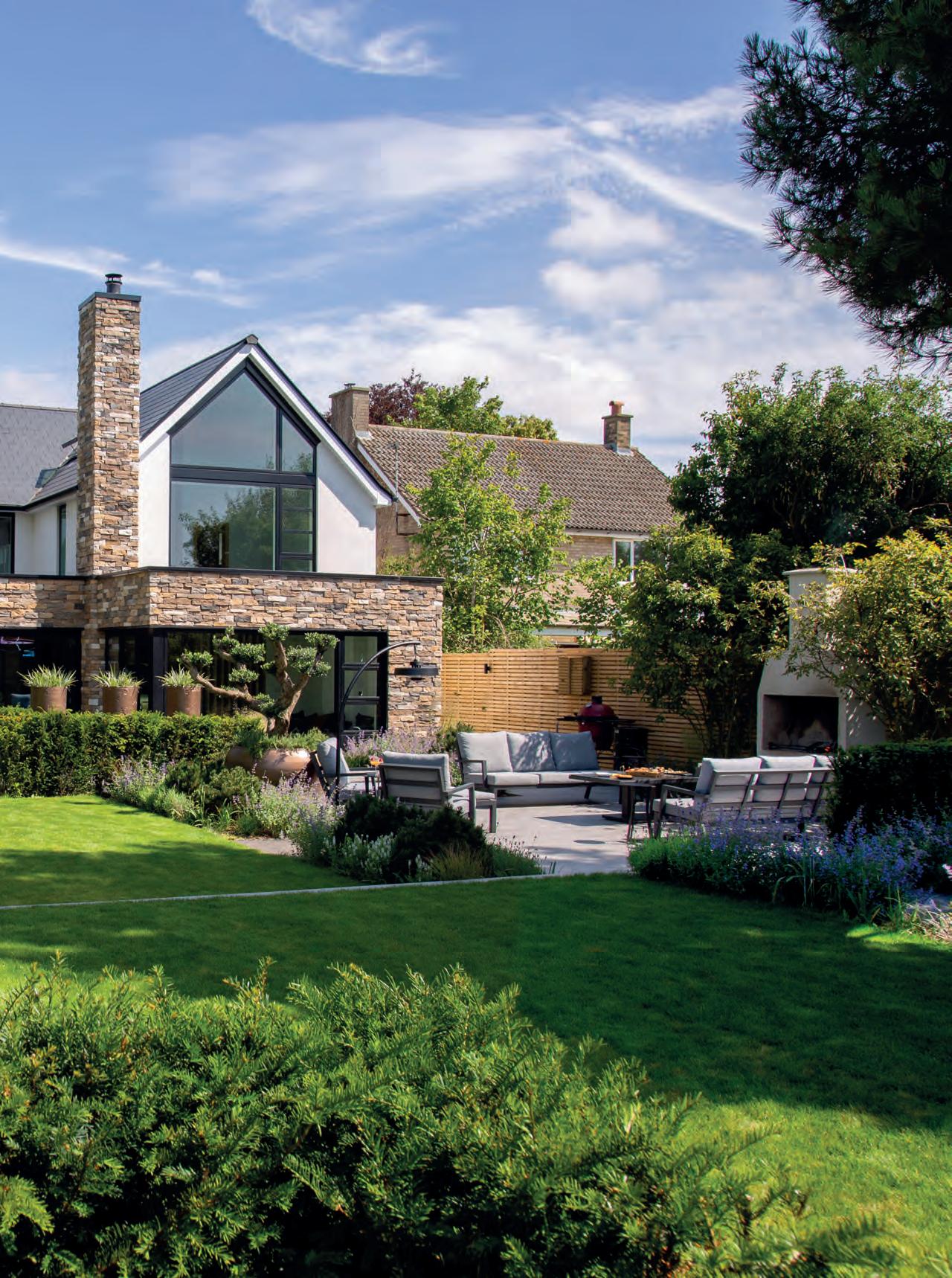

LET'S HEAR IT FROM Ben Walker, Walker Landscape & Design
THE GREEN STANDARD
Bridging the gaps in landscape maintenance
BUILDING FOR THE FUTURE
How will the government’s planning reform impact the industry? APRIL 2025



LET'S HEAR IT FROM Ben Walker, Walker Landscape & Design
Bridging the gaps in landscape maintenance
How will the government’s planning reform impact the industry? APRIL 2025


Eljays44 Ltd, BizSpace, Courtwick Lane, Littlehampton, West Sussex, BN17 7TL Tel: 01903 777 570
Deputy editor – Bethany Vann bethany.vann@eljays44.com Tel: 01903 959 394
Senior subeditor – Katrina Roy katrina.roy@eljays44.com Tel: 01903 777 570
Senior designer – Kara Thomas kara.thomas@eljays44.com
Sales executive – Ollie Finch ollie.finch@eljays44.com Tel: 01903 777 579
Horticulture Careers – Ollie Finch ollie.finch@eljays44.com Tel: 01903 777 579
Managing director – Jamie Wilkinson jamie.wilkinson@eljays44.com Tel: 01903 777 589
Divisional director – David Griffiths david.griffiths@eljays44.com Tel: 01903 777 584
Content director – Nina Mason nina.mason@eljays44.com Tel: 01903 959 393
Commercial director – Luke Chaplin luke.chaplin@eljays44.com Tel: 01903 777 582
Subscription enquiries – Laura Harris laura.harris@eljays44.com Tel: 01903 777 575
Printed by Stephens and George Ltd
Published by ©Eljays44 Ltd – Connecting Horticulture. Pro Landscaper’s content is available for licensing overseas. Contact jamie.wilkinson@eljays44.com
Pro Landscaper is published 12 times per year by Eljays44 Ltd. The 2025 subscription price is £128. Subscription records are maintained at Eljays44 Ltd, BizSpace, Courtwick Lane, Littlehampton, West Sussex, BN17 7TL, UK. Articles and information contained in this publication are the copyright of Eljays44 Ltd and may not be reproduced in any form without the written permission of the publishers. The publishers cannot accept responsibility for loss of, or damage to, uncommissioned photographs or manuscripts.
Whilst every effort has been made to maintain the integrity of our advertisers, we accept no responsibility for any problem, complaints, or subsequent litigation arising from readers’ responses to advertisements in the magazine. We also wish to emphasise that views expressed by editorial contributors are not necessarily those of the publishers. Reproduction of any part of this magazine is strictly forbidden.
Pro Landscaper is proud to be an Accredited Supplier member of BALI
Pro Landscaper is proud to be an associate member of the APL

The idea of owning our own homes was once a common step in life, I would go so far as to say it was expected of us to be homeowners by a certain age. Now it’s more akin to the age old phrase of the American dream, but for many people it is nothing more than a pipe dream. I know talking house prices is much like talking politics with the family, you just don’t do it – it’s a topic that can divide the room –but with the publication of the government’s Planning and Infrastructure Bill (page 71), now seems like a prudent time.
The new Bill is central to the government’s plan to get Britain building again, increase housing supply, and address affordability – but whether this comes to fruition remains to be seen. In theory, more development could create economic opportunities for our industry and partnering sectors. And while successful implementation of affordable housing would be a major benefit for many, it would be negligent to overlook the potential impact on our natural environment.
The Nature Restoration Fund, as proposed by the government, should see a rise in funding for green spaces, and ultimately more contracts. However, I remain trepidatious at the thought about off-site solutions becoming the preferred method, as this could create isolated pockets of biodiversity rather than integrating land-based solutions throughout development – but that’s not to say this Bill doesn’t hold major potential for both the housing market and for the industry.

19
What’s coming up in April 2025?
Off the back of the Autumn Budget, Carpenter Box’s Stuart Noakes highlights what businesses need to know ahead of the impending changes
22
7 Ways to Boost Your Operational Efficiency
Neil Stead shares how businesses can make quick, impactful changes to streamline operations and reduce costs
25
Let’s Hear It From: Ben Walker
From landscape design to luxury outdoor living, Ben Walker is going from strength to strength in the outdoor living market

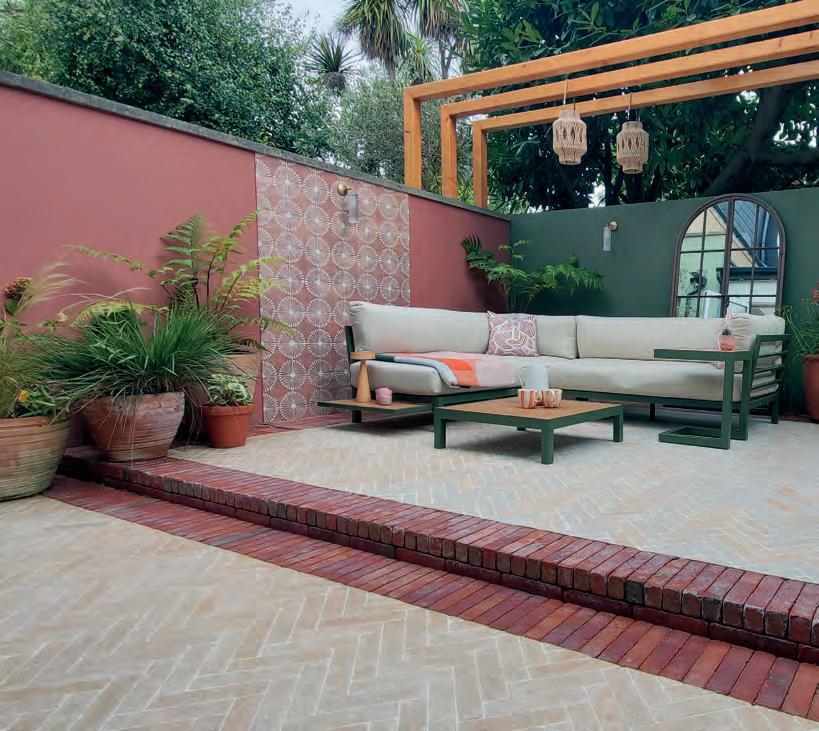
31
Bringing the Inside Out Colour, personality and functionality were the brief for this family courtyard presented to Katerina Kantalis Garden Design
37 Mediterranean Makeover
Consilium Hortus paired contemporary design and timeless charm to bring this Mediterranean infused garden to life
45 Royal Restoration
Where history, nature, and culture meet –Greenwich Park gets a much-needed restoration from Blakedown Landscapes
59
The Green Standard Horticulturist Tom Angel is launching a new grounds maintenance tool to tackle the challenges posed by our utilitarian space
65 The Good Life
From starting as a small nursery in 1895, Boom & Bonheur is now celebrating its 130th anniversary – and it’s got a lot to celebrate
71
Building for the Future
The government’s new planning reforms are likely to have a series of knock-on effects, prompting the question, what impact will it have on our industry?

76
Closer to Home
How even the smaller changes can have a big impact on carbon offsetting with Lewis Normand
78 Comeback Kings
Humaira Ikram shines a spotlight on Fuchsias and how they have become a staple in gardens all around the world
81
An Evolution Chair of the Society of Garden + Landscape Designers, Andrew Duff explores the evolving relationship between garden and landscape design
11
Rooted in Learning
Designer Dave Green’s latest project will see a new hands-on green skills garden with sustainability at its heart brought to life at RHS Garden Wisley
15
Talk of the Trade
Landscapes by Design’s Stuart Reid on winning this year's APL Supreme Award
20
What Would I Do Differently?
If given the opportunity, Gareth Wilson reflects on what he might have done differently throughout his career




Aluxury entertainment space created by Landscapes by Design was the Supreme winner at this year’s APL Awards. Phil Tremayne, general manager of the Association of Professional Landscapers (APL), says the garden is “incredible”. It features a modern bar with a large high-definition TV screen, a fire pit surrounded by a custom-built seating area, and soft lantern lighting.
“What a truly remarkable project – well deserving of the 2025 Supreme Winner title, especially in the APL’s milestone 30th anniversary year,” adds Tremayne.

There were 20 project category winners on the day, as well as a series of special awards. APL Designer of the Year went to Adam Vetere Landscape and Garden Design, whilst Atlantes Landscapes won APL New Company of the Year. There were two winners of the APL’s annual Rising Star awards – Harry Fitzsimmons and

Pro Landscaper is opening nominations for a brand-new initiative that seeks to recognise the nurseries that are the backbone of the landscaping industry. Readers can nominate the trade nurseries that they work with in six separate categories, putting them in the running to become one of Pro Landscaper’s Most Influential Nurseries. There will also be an award for Most Influential Nursery Person of the Year, for which readers can nominate an individual working at a trade nursery who has a significant impact on the sector.
“Nurseries can be the unsung hero of the landscaping industry. They’ve been battling everything from extreme weather
Alan Mayers – and Bury Hill Landscape Supplies won APL Supplier of the Year. Richard Adams Landscapes, Conquest Spaces and InsideOut Home & Garden Improvements were all given a certificate of commendation for engineering in their projects. The APL Awards took place on Friday 14 March at The Brewery in London. They were hosted by Tremayne and Peter Donegan, with fellow garden designer Pip Probert as a guest speaker.
“A big well done to all the finalists; the competition has never been tougher, and winning any medal at these awards is an outstanding accomplishment. Well done to everyone involved, and we look forward to seeing you in 2026.” landscaper.org.uk

The first FutureScape USA will be taking place in California this year, bringing together each sector of the landscaping industry under one roof.
Having won numerous awards in the UK, the trade show will be expanding into the US, with the inaugural event being held from 9-10 December at the Los Angeles Convention Center.
Landscapers, garden designers, landscape architects, installers, groundscare operatives, local authorities and more across the landscaping industry will be able to see the latest innovations and trends on the market.
Seminars, workshops and live demos from leading experts and suppliers are set to take place across the two-day event.

conditions to the significant changes to plant import rules. So, we’re launching Pro Landscaper’s Most Influential Nurseries to shine a light on these fantastic companies up and down the country", says Pro Landscaper’s content director, Nina Mason. The seven categories are: Best value for money, best customer service, biosecurity, best product range, climate resilience, best contract grower, and most influential nursery person of the year. Nominations will close 10 April, following which the finalists will be determined for each category. These will then go out to a public vote, with the ultimate winners being announced on 29 May. The winning nurseries and nursery person will collect their awards at Pro Landscaper’s Summer Showcase at DeVere Horsley Estate, Surrey, on 11 July. Scan the QR code to nominate now!
It will provide a key networking opportunity for those based on the West Coast and further afield, as well as offering essential insight into the future of landscaping, from sustainable solutions to those focused on climate resilience.
The first FutureScape Global will also be taking place in Saudi Arabia this year.
For more details, contact show director Tom Glasby by email at: tom.glasby@eljays44.com
The Landscape Institute (LI) fears potential biodiversity loss as a result of the government’s new Planning and Infrastructure Bill. Announced by deputy prime minister and secretary of state for housing, Rt Hon. Angela Rayner MP, the bill sets out several measures designed to speed up planning decisions. LI is ‘concerned’ that changes to the Nature Restoration Fund outlined in the bill could allow developers to opt out of on-site mitigation obligations. “This could lead to biodiversity loss and a reduction in people’s access to nature –vital for our health and wellbeing. Instead, we advocate clear safeguards that retain and strengthen on-site mitigation and robust biodiversity net gain requirements for any size of development to contribute to”, says

Developed to support garden designers, landscape architects, and landscapers bolster their natural capital when designing and creating outdoor spaces, the new green design tool, elemental launched on 19 March. A condensed version of the tool debuted at the RHS Chelsea Flower Show last year, where it reduced carbon emissions across all show garden categories by 25%. The web- based app will calculate a project’s score based on questions across five categories;
Carolin Göhler FLI, president of the LI. She adds that “on-site mitigation is crucial for genuine, long-term benefits for people, place and nature.” The LI is urging the government to engage ‘closely’ with

landscape professionals to “ensure sustainable, resilient natural environments that support the wellbeing of communities.” More information on the bill can be found at: gov.uk/ government/publications/theplanning-and-infrastructure-bill.
material management, soils, water and air, biodiversity, and people. Liz Nicholson, managing director of Nicholsons and who spearheaded elemental, says: “It’s centered around natural capital…it’s not just about carbon, it’s about climate and nature and the impacts that humans are having on the planet.”
She adds that the tool is intended to be a “design tool rather than an accreditation process.” Nicholsons, alongside the SGLD, BALI, the LI, and the RHS are all funding the tool. It is also being supported by the HTA and the APL. It will be free to access – for members of the partnering organisations.
Additional sponsorship is being sought after to ensure the tool can continue to evolve over time and offer even more additional support in creating climatepositive, nature-friendly spaces.


HUGO BUGG: “WE ARE GUIDED BY A STRONG ETHOS OF ENVIRONMENTAL RESPONSIBILITY.”
Harris Bugg Studio‘s co-founder Hugo Bugg delves into how the practice continues to champion sustainability throughout its projects.


NURTURE GROUP’S SUE WISHART ON ADVANCING DIVERSITY AND WOMEN EMPOWERMENT
This year’s theme for International Women’s Day, “Accelerate Action,” invites us to speed up efforts toward greater gender equality and inclusion.


DARREN STOBBART ON THE LAST 10 YEARS SINCE FOUNDING THE PLANTMAN & CO
From what inspired him to launch the company, and how it has progressed over the last decade, to how interior landscaping trends have evolved.
NEW STUDY SHOWS OVER THIRD OF BRITAIN WANTS ARTIFICIAL GRASS
Data reveals 36% of people living in Britain would support a ban on artificial grass. According to research from MyBuilder, the percentage of people who would support a ban has risen 50% since last year. Data from the trade hire company shows enquiries for artificial grass installation were

down 48% year on year in 2023, with a 20% drop since 2023 in Google searches for the product.
Over half of residents in Edinburgh say they would support a ban, while Manchester showed the least support, with 32% in favour.
James Lewis, gardener from MyBuilder says that widespread
negativity in the media, and concerns for how artificial grass affects wildlife has caused these concerns.“After an extremely wet 2024, Brits are understandably really worried about flooding and the damage it can cause to property and gardens." The data shows support for the ban was universal across all age groups and is consistent for men and women, while geographically there are some variations.

ARTEMIS TREE SERVICES
BLAKE TREE CARE LTD
CONNICK TREE CARE
GRISTWOOD & TOMS
MAYDENCROFT
ROCKLEIGH LTD
COMMERCIAL LANDSCAPE COMPANY
KINGSTON LANDSCAPE GROUP LTD
MAYDENCROFT
NT KILLINGLEY LTD
PANORAMIC LANDSCAPE CONTRACTORS
PLANET TURF LTD
DESIGN AND BUILD COMPANY
CHAMPAIN GROUP LTD
THE GARDEN COMPANY LTD
UTOPIA LANDSCAPES
WILD BY DESIGN LTD
WRIGHT LANDSCAPES LTD
DIVERSITY AND INCLUSION STRATEGY
iDVERDE
JOHN O’CONNER (GROUNDS MAINTENANCE) LTD
KINGSTON LANDSCAPE GROUP LTD
MCNAUGHTON’S LANDSCAPING LTD M SQUARED
NICHOLSONS
NURTURE GROUP
ROCKLEIGH LTD
TYLER GRANGE
WRIGHT LANDSCAPES LTD
GARDEN DESIGN COMPANY UNDER £250,000 TURNOVER
BRADLEY BURGESS DESIGN
CHARLOTTE SANDERSON GARDEN DESIGN LTD
FELICITY O’ROURKE GARDEN DESIGN
KAREN TATLOW GARDEN DESIGN
NIGEL PHILIPS ‘ONE-TO-ONE’ GARDEN DESIGN SERVICE
SOPHIA’S GARDENS
GARDEN DESIGN COMPANY OVER £250,000 TURNOVER
CONSILIUM HORTUS LTD
KAREN MCCLURE GARDEN DESIGN LTD
LAVENDER LANDSCAPES / NZM LTD
MATTHEW WILSON GARDENS (MWG)
THE GARDEN COMPANY LTD
THE GARDEN ROOM LIVING & LANDSCAPE STUDIO LTD
WEST HILL GARDEN & LANDSCAPING SERVICES
ELMTREE GARDEN CONTRACTORS LTD
GLENDALE COUNTRYSIDE LTD
MCNAUGHTON’S LANDSCAPING LTD
NURTURE LANDSCAPES
PLANET TURF LTD
SKY HIGH TREE & GROUND
MAINTENANCE SERVICES LTD
TCB GROUNDS MAINTENANCE LTD
FUND4TREES IN COLLABORATION WITH ARBORICULTURAL ASSOCIATION, RHS, TREE COUNCIL AND NURTURE GROUP
HELMRIG LTD IN COLLABORATION WITH MULTIPLE INDUSTRY SPECIALISTS
LANDFORM CONSULTANTS LTD (THE GLASSHOUSE COLLECTIVE) IN COLLABORATION WITH MULTIPLE COMPANIES AND TRADE ASSOCIATIONS/CHARITIES
NICHOLSONS IN COLLABORATION WITH RHS, BALI, LI, SGD AND APL
ROBERT JOHNSON GARDEN DESIGN LTD IN COLLABORATION WITH ALFRESCO LANDSCAPING
TUBEX IN COLLABORATION WITH YORKSHIRE
DALES MILLENNIUM TRUST AND VARIOUS FORESTRY SECTOR STAKEHOLDERS
PROVENDER NURSERIES LTD FOR THE INVESTMENT IN PROVENDER NURSERIES LTD
GROUND CONTROL LTD FOR THE ACQUISITION IN THE DEVANA CENTRE FOR ENVIRONMENTAL RECOVERY
NURTURE GROUP FOR THE ACQUISITION OF TIVOLI GROUP LTD

LANDSCAPE
ARCHITECTURE STUDIO
CAMLINS
GREENWOOD-HILL LTD
HARRIS BUGG STUDIO
HILL-WOOD & CO KENT LTD
WYNNE-WILLIAMS ASSOCIATES LTD
LANDSCAPE COMPANY
UNDER £1M TURNOVER
BELLA LANDSCAPE CONSTRUCTION LTD
C J LANDSCAPES LTD
CONSILIUM HORTUS LTD
D & S PRECISION LANDSCAPING LTD
GEL LANDSCAPING AND GROUNDWORKS LTD
WILD BY DESIGN LTD
UTOPIA LANDSCAPES
LANDSCAPE COMPANY
£1M - £2.5M TURNOVER
ANDERSON LANDSCAPING LTD
BUTLER LANDSCAPES
CHAMPAIN GROUP LTD
E WILLIAMS LANDSCAPES LTD
WATER GEMS (ALBA) LTD
LANDSCAPE COMPANY
£2.5M - £5M TURNOVER
KIERON BEATTIE LANDSCAPING LTD
PALMER LANDSCAPES LTD
TAMAR LANDSCAPES LTD
WILKINSON LANDSCAPES LTD
LANDSCAPE COMPANY
OVER £5M TURNOVER
GROUND CONTROL LTD
KINGSTON LANDSCAPE GROUP LTD
M SQUARED
NT KILLINGLEY LTD
PANORAMIC LANDSCAPE CONTRACTORS
WRIGHT LANDSCAPES LTD
ARLINGTON LANDSCAPES
BRIDGEMAN KENT LTD
G TROTT TREE CONSULTANCY
J’SONS GARDEN SERVICES LTD
MODULAR GARDEN DESIGNS LTD
NUVO OUTDOOR LIVING LTD
RAY HORTICULTURAL RENDERS
SUPPLIER AND SERVICE PROVIDER
AZPECTS LTD
GREEN-TECH
GREENFIX SOIL STABILISATION AND EROSION CONTROL LTD
MMCITÉ UK LTD
LONG RAKE SPAR
PLATIPUS LANDSCAPE SOLUTIONS
TECTONIX NATURAL STONE LTD
SUSTAINABLE COMPANY OF THE YEAR
JOHN O’CONNER (GROUNDS MAINTENANCE) LTD
TENDERCARE NURSERIES LTD
TYLER GRANGE
TRADE NURSERY OF THE YEAR
EVERGREEN EXTERIOR SERVICES
ROBIN TACCHI PLANTS
TENDERCARE NURSERIES LTD
WYEVALE NURSERIES
HEADLINE PARTNER






CATEGORY PARTNERS DRINKS PARTNER



W e grow unique character trees – trees with strong shapes, and with a natural, aged look. These trees add charm and personality to any garden or landscape. Our selection of trees are carefully nurtured and develop their very own distinctive forms. Whether you need a statement tree for a park, a stylish addition to a garden, or a striking tree for an urban space, our character trees create a lasting impression. Visit our nursery and get inspired by our impressive stock of eye-catching trees. Boom & Bonheur – because trees give life and bring happiness!
Boom & Bonheur BV boombonheur.com
• Euonymous Europeaus Red Cascade
• Alunus glutinosa Imperialis
• Prunus avium 'Plena'
• Lychnis flos-cuculi
• Geum rivale
• Carex divulsa
• Erigeron karvinskianus 'Profusion'
• Lychnis coronaria 'Alba'
• Nepeta racemosa 'Walker's Low'
• Hedera helix ‘Glymii’

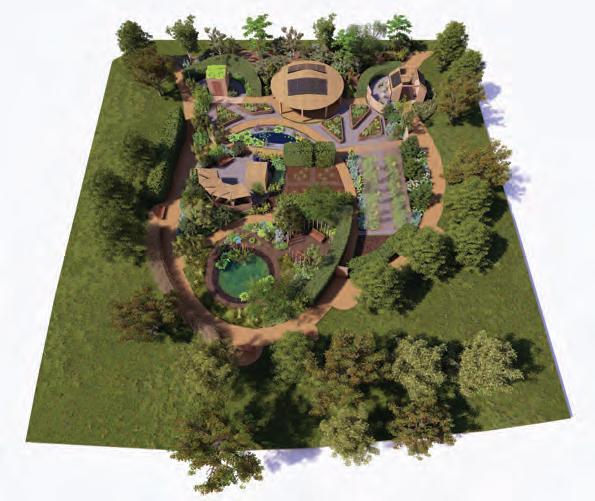
How the new Green Skills Garden at RHS Garden
Wisley is combining sustainability and hands-on learning to offer aspiring horticulturists a space to grow
WORDS: BETHANY VANN
Creating accessible green spaces is arguably more important than ever. Designing environments where people from diverse backgrounds can connect with nature while also gaining new skills is no small task. The new 'Greener Skills Garden' at RHS Garden Wisley aims to do exactly that – offering aspiring horticulturists hands-on experience in ecofriendly gardening. For designer Dave Green of Dave Green Gardens, this “high-profile project” is a full-circle moment. After having trained at Wisley, he says: “To now be going back and working on a space that has learning and accessibility at the heart of it feels incredibly special.”
The garden, which is a collaboration between RHS science and the charity’s New Shoots initiative, will also have a strong overarching “sustainability ethos”, identifiable in several of the off-grid garden’s features, including a green roof, several living walls and the solar panels which will power the site’s propagation equipment.
“We're sourcing a lot of materials from the local area, from timber, path materials, and a lot of reclaimed materials as well –sustainability weaves through the whole thing.” Green’s design also brings about two firsts for the charity – the rain garden will be the RHS Garden Wisley’s first and will be propagated through a sustainable drainage system that will channel water runoff into a wildlife pond, which in turn will flow onto the rain garden. And a first for the charity as a whole will be the on-site composting toilet; humanure from the toilet will be “thoroughly decomposed” and put back into ornamental areas of the garden as soil improver. “This space is going to be very different”, says Green. The large composting/recycling area will ensure “everything will be reused”.
that they wanted to do and say in the garden, trying to distil them into something that's tangible, and physical is different.” Another challenge came in the form of balancing biodiversity considerations: “We're creating a garden in a well-known public space, and the existing metrics don’t always account for garden planting.” With the introduction of new pathing, the team had to find creative ways to offset its impact, incorporating additional tree planting and other green initiatives. “It's very complex, but nature is very complex, isn't it? We're trying to do the best we can to bring people closer to it.”
If we can offer a space where people can learn the skills involved in nurturing the outdoors and trying to improve the environment, the huge number of benefits that brings sells itself, doesn't it?
When the garden opens later this summer, “it won’t be fully planted – it's going to evolve over time," Green explains. Users of the garden will not only be able to witness it grow but will also have a hand in influencing its development as it will also function as an outdoor classroom for the New Shoots Programme – which was also a source of inspiration for Green, as he notes: “I took the idea of how a seed first emerges to influence some of the shapes in the garden.”
Green says while it has been a rewarding experience, there have been “challenges” along the way. “The team had a vast loop of things
Green has long been recognising the benefits in creating accessible spaces for people of all backgrounds. “There's a real lack of facilities and opportunities for people in different situations.” From those living in urban environments, to those who are intimidated by wild spaces; “the more we can design spaces that facilitate people to interact and become more involved with the outdoors, the better.” The garden will not only work to rectify the lack of accessibility, but it will also be used as a platform for supporting those looking to gain more horticultural experience. “If we can offer a space where people can learn the skills involved in nurturing the outdoors and trying to improve the environment, the huge number of benefits that brings sells itself, doesn't it?”
The RHS Garden Wisley Greener Skills Garden is just the first garden of its kind that the charity has planned, a second garden is planned for later this year at RHS Garden Bridgewater, with the end goal of establishing sustainable learning gardens at all the charity’s gardens.

SIMPLE TO INSTALL
MAINTENANCE FREE
EDGING
RINGS

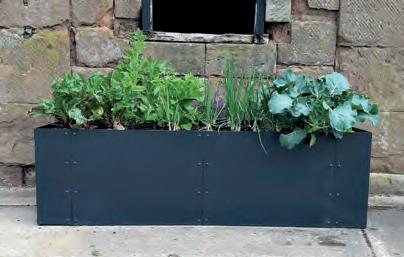
AFFORDABLE
LASTS A LIFETIME
PLANTERS



From stockbroker to the APL Awards’ supreme winner this year – Landscapes by Design’s Stuart Reid is reaping the rewards of trading the city for the outdoors
WORDS: NINA MASON
When Stuart Reid put Landscapes by Design’s project, Apollo, in for this year’s APL Awards, he’d expected at least a Gold – but like everyone else who enters, he’d hoped to win Best in Category. What never crossed his mind was taking home the Association of Professional Landscapers’ Supreme Award, which is exactly what happened at the ceremony on 14 March at The Brewery in London.
“Sometimes I still feel like we’re this little landscaping company from Essex that no-one knows, so it’s great to be recognised at these awards in front of such high-end landscapers,” says Reid. “We thought the design and the build of the garden commanded an award, but when you’re building it, that’s not what you’re thinking. We just built it to the same high specification and technique and attention to detail that we do all our gardens.”
He thought the spaceship – yes, you read that right – might make it stand out. The client loved the design by DesignScape’s Paul Newman but wanted one more item added. He’d seen Apollo in Timothy Oulton’s studio in London and wondered if Newman and Reid could fit it in.


“I thought it would be a mirrored sculpture at first but when he turned around his iPad, it was a spaceship. I told him I’d buy it the next day so it could be delivered as soon as possible for us to build the garden around it.”
The stainless steel capsule is built to the same scale as Apollo 11, with a plush, padded interior surrounding a table with a chandelier for lighting dangling over it. It's undoubtedly a focal point, but the rest of the garden is equally as impressive.
Led by project manager Rob Giles, Landscapes by Design had to overcome challenges with drainage, utilising a large soakaway area, and move a considerable amount of soil to create the sunken seating area. “Then there’s the number of cuts needed to achieve the end result – the majority of the stone was mitered or bull nosed, which was all done on site. There were 12 people on site at times, from electricians to structural engineers. It was technically challenging, but we had a great client.”
The luxury entertainment space now features a modern bar area, a 10m2 high-definition TV screen and a custom-built seating area with a fire pit at the centre – all unsurprisingly putting it firmly in the ‘Project Value over £250,000’ category.
This isn’t unusual for Landscapes by Design though, which Reid says can take on both large and small projects. He’s built up the company’s reputation over 25 years, founding it after leaving his job as a stockbroker in the city. With two children to support, his parents encouraged him to get a “proper job” as soon as possible and suggested landscaping.
“I’d always liked working with my hands and being outside, so it stemmed from that – no real thought went into it. I just started the company and enrolled in Writtle College on a three-year course, which I couldn’t even finish because I got so busy with work.”
We thought the design and the build of the garden commanded an award, but when you’re building it, that’s not what you’re thinking. We just built it to the same high specification and technique and attention to detail that we do all our gardens
Reid says taking on a business partner five years ago has been pivotal for the company, though.“He’s not a landscaper; he’s my business mentor and one of my oldest friends who made me realise I was holding the business back by being too on the tools. I was being too fastidious in my approach and not realising the talent that I had working for me. So, I came off the tools – under much duress

and worry – and the business has grown ever since.”
It has sparked Reid to consider starting a podcast from a business perspective, aimed at young landscapers to help them understand where their skills lie – do they want to be artisans or run a business? “It’s very different, and that’s the way my business has gone. From a one-man-band with staff that came and went for 20 years to the last five years when it’s grown and grown. People have returned to the company who used to work for me and now run the landscaping on site and have had a tremendous impact on the business. So, I was definitely holding the business back.”

He’s now in the office full-time with office manager Charlotte Barrett, which has given him the opportunity to focus on the business, quoting, and going to see clients – as well as entering awards. “The company can sustain it now, whereas five years ago, I wouldn’t have had the time.”
Landscapes by Design became a member of the APL many years ago to help the
business too. The cluster meetings offered a chance to speak to others running similar businesses to understand the challenges that they’re facing and to help set a benchmark for the company’s performance. It also boosts your confidence and credibility, says Reid.“It’s

a vetted organisation and there are standards that need to be upheld, so from my point of view, the APL is essential, especially for up-and-coming landscapers that need to build client trust before they even break ground.”
It's certainly proven beneficial for Landscapes by Design which, far from being an unknown company, has become a hot topic and no doubt an inspiration for those hoping to secure their own Supreme Award one day.





Mott MacDonalds’ Jonathan Ramsay on defining, managing, and delivering landscape benefits through ecosystem services
Throughout history, it has been recognised that human society benefits from the environment in various direct and indirect ways. Contemporary landscape design is increasingly drawing on inspiration from natural systems to sustainably meet human needs. The Ecosystem Services concept is a useful framework for identifying a wide range of benefits from the external environment. The modern-day concept of Ecosystem Services emerged in the mid-1980s (Ehrlich and Mooney 1983) and has now become the basis for an expanding body of policy, standards and guidance which can be used as subsets of this framework. The main categories of ecosystem services are:
• Regulating services: natural processes that help regulate climate, water quality, and disease control.
• Cultural services: non-material benefits such as recreational, aesthetic, and spiritual experiences.
• Provisioning services: the production of harvestable resources.
• Supp orting services: fundamental to produce all other ecosystem services, including soil formation, nutrient cycling, and habitat provision.
As designed landscapes span both the arts and sciences, there is a tendency to shy away from interrogating these proposals against performance criteria, unlike other design disciplines. This is not a helpful approach as it can fail to identify and maximize benefits and leaves the landscape vulnerable to cost-cutting. For major projects, long and intense delivery programmes can increase the risk of losing the overall vision. Establishing a robust benefits management approach based on measurable performance criteria can help maintain continuity and align the goals of clients, designers and construction teams.

Biodiversity conservation: Healthy plants and soils within new landscapes provide a native species habitat and act as a good neighbour to existing ecosystems.
Performance criteria Benefits
• Increase of 30% in biodiversity net gain using the Natural England metric.
• Provision of four Great Crested Newt (GCN) ponds on site size, from 100-300m2, with no less than 1.5m depth maintained all year round.
• GCN ponds designed to meet English Nature (2001) GCN Mitigation Guidelines.
• Estimated eight-week negotiation period saved in design programme by meeting GCN mitigation licensing criteria.
• Fulfils local wildlife trusts leasing clause for adopting the site management, saving approximately £150k in whole life management costs (2025 prices).
• Provides one full time equivalent apprentice for new management organisation.
Rigorously identifying targeted benefits from the outset allows for:
• Standards and legal frameworks to follow.
• Measurements and tolerances to assess benefits.
• Continued business case and investment appraisals to monitor benefits against cost, scope, programme, quality, sustainability and risk.
Contemporary landscape design is increasingly drawing on inspiration from natural systems to sustainably meet human needs
• Evaluating options for achieving benefits, often with landscape elements, offering multiple combined benefits
During a recent project, we at Mott McDonald identified performance criteria and associated benefits under the ‘Regulating Service’ category. Senior associate in the Environment, Nature and Consents division at Mott MacDonald. Ramsay is a landscape architect currently focused on landscape projects where nature recovery is the primary objective.
Water management: Landscape design to incorporate sustainable urban drainage systems for water purification, flood regulation and irrigation
Performance
• Retain 100% of stormwater on site.
• Attenuation features to drain down to a dry basin in approximately 72 hours after a 1:100+ year climate change storm event.
• Estimated six-week time saving in planning stage to meet approval criteria by Civil Aviation Authority.
• Save £25k in connection fees and infrastructure costs to water authority.
• Multidisciplinary interdependency analysis and coordination.
• Preparation for operational (in use) phases of the project.
By leveraging benefits through intelligent design, we have shown that designed landscapes can contribute significantly to the performance of our environment.

Email london@mottmac.com mottmac.com
The 2024 Autumn Budget introduced key changes taking effect from April 2025, impacting businesses across sectors. From employer National Insurance contributions (NIC) to minimum wage increases, these updates could affect your costs. We’ve highlighted the key points to help you prepare with confidence.
From 6 April 2025, employer NIC rates will rise from 13.8% to 15%, and the threshold for paying employer NIC will drop from £9,100 to £5,000 per employee per year. This change could increase your payroll expenses. The good news? The Employment Allowance is increasing, which could help offset some of these costs.
To help support businesses, the Employment Allowance will be increasing from £5,000 to £10,500 from April 2025. In addition, the £100k cap that previously excluded larger businesses is being removed.
Carpenter Box’s Stuart Noakes explains what businesses need to know about the impending changes for April
This means more businesses, whether large or small, can benefit from National Insurance savings, freeing up money to reinvest in tools, equipment, or expanding your team.
If you have employees, it’s important to factor in the upcoming minimum wage rise.
From 1 April 2025, the National Living Wage (NLW) for workers aged 21 and over will increase from £11.44 to £12.21 per hour. There are also increases to the wage rates for workers 20 and under:
• Aged 18-20: £10 per hour
With these updates on the horizon, now’s the time to take stock and make any necessary adjustments to your business finances
• Under 18s and apprentices: £7.55 per hour
For landscaping businesses that rely on seasonal or full-time staff, this means a higher wage bill. Now’s the time to review your pricing and budgets to ensure your business stays on track.
If your business depends on vans, trucks, or other vehicles to transport materials and workers, there’s some positive news; the government is keeping the fuel duty freeze in place and retaining the 5p cut until 22 March 2026. This means you won’t see an increase in fuel tax, helping you keep your budgeting more predictable.
Many landscaping businesses use double cab pick-up trucks for their work, but there’s an important tax change coming. From 6 April 2025, these vehicles will be classified as cars for tax purposes. This means they’ll be subject to the same benefit-in-kind (BIK) tax rates as company cars, rather than the more favourable commercial vehicle rates. Vehicles bought before April 2025 will still be eligible for the current tax treatment until April 2029 (or until disposal, lease expiry, or sale).
With these updates on the horizon, now’s the time to take stock and make any necessary adjustments to your business finances.

STUART NOAKES
Stuart Noakes is
At Carpenter Box, we’re helping clients recalibrate their tax strategies to stay compliant and efficient. We can review your financial affairs to ensure you’re not overpaying tax and assess whether existing structures remain suitable. If you would like more detailed one-to-one advice for navigating these changes, get in touch with our tax team. Tel 01903 234094 Email info@carpenterbox.com carpenterbox.com
After being asked the question recently, Gareth Wilson considers what he might have done differently throughout his career
In January, I made my annual visit to Scotland to do my CPD for the Society of Garden and Landscape Designers. I was asked the million-dollar question: What would I do differently if I had my time again in landscaping? I wasn't exactly lost for words, but my mind went into overdrive. I raised many points there and then, but many important ones were missing. Now that I've had time to think, I've put together my top 10 things I'd do differently – here is part 1.
Health is wealth
Beyond a doubt, and above all else, my number one answer will always be to take great care of yourself mentally and physically. All too often, I didn't, and it caught up with me in 2019, which I look back upon now and wonder how I got through that year. I’ve mentioned before that having maintenance schedules for your vans, power tools, and plants is essential for the smooth running of your business. Equally important are regular health checks and massages – and yes, I even do yoga these days.
Working with designers
designers' budgets by reducing your costs, even if the project would look amazing on your website – it doesn’t work. I did find this out the hard way in the early days, and it cost me a few quid.
Push yourself
I started building show gardens in 2012. I was 40 then, and you know what they say about life beginning at 40, it certainly did for me. I wish I’d gotten into building show gardens earlier, as you’re mixing with the elite in landscaping and learning from them. I remember every part of Mark Gregory’s lecture at Westminster for first-time contractors and designers; I was in awe and still am today.
I wish I’d gotten into building show gardens earlier, as you’re mixing with the elite in landscaping and learning from them
Joining governing bodies or industry schemes
I always enjoyed working with my regular designers. We built up an understanding and good working relationship, which was crucial, especially in the early stages of specification. We also gave clients realistic cost-related designs for their projects. Adam Vertere and Justin Himpson have, in my opinion, got the formula down to a tee, and their awards record shows. My advice, however, is don’t try to match
Similar to the above, it’s all about raising your game, installing your projects to the highest standards, meeting new contractors, and broadening your network of people. Once you build rapport with like-minded contractors, you will find that you help each other, whether borrowing a whacker plate, a sponge cleaner, or just general help and advice, which I see firsthand with the Marshalls Register guys in the North West, which has been built up over a number of years
by Jason Clarke (NSC).
Being a member also allows you the opportunity to enter awards and add more kudos to your company. I joined Bradstone, the British Association of Landscape Industries and the Association of Professional Landscapers far too late, I should have done it years before.
If it doesn’t feel right, walk away I wish I'd learnt this lesson much sooner in my landscaping life. If I had £10 for every time I’ve said this, I’d be able to retire a few years earlier than I am now. One of my first articles in Pro Landscaper discussed "the gut feeling” and “trust your gut.”
Suppose you have that gut feeling regarding a client or a project. In that case, it’s far easier not to get involved in a potentially problematic situation which can affect your mental health and pocket. Remember, those types of clients are out there, and you must protect yourselves with a contract with terms and conditions and, preferably, an email paper trail.
As a side note, a sunset clause in your contracts is essential, which allows you to walk away from the project if things become intolerable.

GARETH WILSON
Leaving college at 17, Gareth has worked in the landscape industry since 1989. Progressing onto highend projects, he has picked up seven RHS gold medals. He is a member of multiple professional bodies. He provides technical and product advice to large companies, mentors and trains contractors and garden designers in landscape construction and on show gardens logistics across the UK. Gareth also provides mediation services, he is a member of the BS7533:102 committee and is an industry awards judge. gkwilsonlandscaping.co.uk



Transform your landscape with our John Chambers wild ower seed range. Create a versatile, low-maintenance space with visual impact – a biodiverse environment with ecological bene ts.
The John Chambers wild ower seed range includes:
• Over 80 British native wild ower mixes
• Mixes for speci c soil conditions or owering periods
• Mixes to attract speci c wildlife or insects
• Vibrant mixes to create beautiful features
The range also includes wild ower bulbs, grass seed, wild ower matting, insect and wildlife habitats. So whatever your project aspirations, we have the perfect product for you this spring.
Order now for Spring sowing Request or download our brochure today

Order today by calling 01423 332100 or visit www.green-tech.co.uk sales@green-tech.co.uk
Landscaping businesses can face challenges with resource management, customer demands, and operational efficiency. Fortunately, the flexibility of being a smaller business gives an excellent opportunity to make quick, impactful changes that can streamline operations, reduce costs, and improve client satisfaction. Here are a few of the key strategies tailored to the unique challenges and opportunities of a landscaping business, helping you optimise your operations for long-term success.
Map core processes
In landscaping, key processes like quoting, scheduling, procurement, service delivery, and customer follow-up are essential. Mapping these steps helps identify inefficiencies, delays, and areas for improvement. Consider the following:
• Estimates, quotes and scheduling: Use software tailored for landscaping companies to help with estimating, scheduling, and invoicing, ensuring consistency and accuracy.
• Pro curement and supply chain: Landscaping requires constant supply of materials. Optimise your inventory management to prevent over-ordering or running out of critical materials mid-job. Building good relationships with local suppliers can help with both cost management and material availability.
Neil Stead shares how small businesses can adapt to become more efficient – and ultimately, more profitable
Invest in tech Technology can be a game changer for any small business. With the right tools, you can improve scheduling, customer management, invoicing, and even marketing. Some key areas where tech can support your business include:
• CRM systems: Customer Relationship Management (CRM) software can help you track customer interactions, manage communications, and ensure follow-ups are timely. This also helps improve customer satisfaction by keeping your clients informed at all stages of their projects.
• Fleet and equipment management: You likely rely on a variety of tools and vehicles, so implement a system (be that a spreadsheet or software) that will help you to monitor your vehicles’ and equipment’s location, usage, and maintenance needs. Regular maintenance of your equipment can avoid costly breakdowns during busy periods.
• Invoicing and payment: Ensure your business is getting paid promptly by investing in invoicing software (such as Xero or QuickBooks). These tools allow for fast, accurate billing and seamless integration with your accounting system.
As the business owner, it’s all too easy to fall into the trap of micromanaging – especially when managing crews on site. However, delegation is key to operational efficiency. Start by evaluating your team's strengths. If you have skilled landscapers, empower them to manage specific aspects of a project, such as client communication or material procurement. This allows you to focus on strategic growth, while your team handles day-to-day tasks. Consider establishing clear lines of responsibility for both on-site and office staff. For example:
• On-site supervisors: These team members should be in charge of ensuring that all jobs are completed to specification and that equipment and materials are used efficiently.
• Office managers: For scheduling, client communications, and financial oversight, ensure someone is assigned to handle these administrative duties so you can focus on growing the business.
Standard operating procedures (SOPs) are critical in any business, but they are particularly important in landscaping, where each project can vary greatly in scope, design, and requirements. SOPs help ensure consistency and quality across all operations, regardless of the size of the job. For example, an SOP for a lawn maintenance job could include:
• A checklist of tasks (for example, mowing, trimming, edging and waste removal)
• Time estimates for each task
• Equipment needed
• Safety protocols
• A customer feedback loop for post-service reviews Similarly, you could have SOPs for other areas like estimating, handling customer complaints, or performing garden design consultations. These SOPs will not only streamline workflows but also ensure your team delivers a consistent experience to every client.
Time is one of your most valuable resources. Tight schedules and varying weather conditions can make it difficult to stay on top of everything. Effective time management can improve operational efficiency by reducing wasted time and ensuring that jobs are completed on schedule. Here are a few techniques:
• Job prioritisation: Use a priority matrix to assess tasks based on their urgency and importance. For example, high-value contracts should be completed on time, while smaller jobs can be rescheduled if necessary.
• Time blocking: As a business owner, you need to balance your ‘on-the-tools’ and ‘on-the-business’ time. Allocate specific blocks of time to work on client proposals, marketing efforts, and team meetings.
• Weather considerations: Weather plays a big role in landscaping, so create buffer times in your schedules in case of delays. Having a weather tracking tool (such as Met Office Business) that will help you better predict weather and adjust your schedule accordingly.
To gauge the health of your business, you’ll need to track Key Performance Indicators (KPIs). These metrics can help you make informed decisions and identify areas for improvement. Important KPIs for a landscaping business might include:
• Job completion: Are projects being completed on time and to the required standards?
Embrace a mindset of continuous improvement, where you regularly evaluate your operations and seek out new ways to improve
shows, you can stay up to date with new and emerging trends. Look to encourage operational feedback from your team, as they’re directly involved in executing the daily tasks. Regularly review your processes and be open to new methods or systems that can improve your efficiency and client satisfaction.
Conclusion
• Customer satisfaction: Use feedback surveys or online reviews to measure how satisfied your clients are with the service.
• Cost of Goods Sold (COGS): Keeping track of all project costs will help you monitor and maintain profitability.
• Employee productivity: Are your teams meeting their targets? Monitor performance in terms of job completion times and quality of work.
The landscaping industry is constantly evolving. New tools, techniques, and trends emerge every year, and to stay competitive, your business must adapt. Embrace a mindset of continuous improvement, where you regularly evaluate your operations and seek out new ways to improve. And by attending local and national horticulture and trade
Improving the operational management of your business requires a combination of strategic planning, technology integration, and empowered teams. By mapping out your core processes, investing in the right tools, delegating responsibilities, and focusing on continuous improvement, you can create a more streamlined, efficient operation that allows you to scale while maintaining high standards of service.
The key is to start with small, manageable changes and consistently look for ways to improve your business’ processes.

BOOSTING
Conclusion
Neil Stead is an accomplished Business Consultant & Coach with three decades of experience at one of the UK's most respected brands. In 2021, he established Steady Consulting to partner with small business owners, helping them build stronger, more sustainable businesses – benefiting their customers, employees, and aligning with their personal aspirations. Stead focuses his expertise on the horticulture and landscaping industry – providing tailored, hands-on guidance, strategic advice, and dedicated support. He will also bring his expertise to the Pro Landscaper Business Awards as a judge. To book a free discovery session, scan the QR code. steadyconsulting.co.uk








Bourne Amenity have been supplying hard and soft landscaping materials to the industry for over 40 years.
From standard BS3882:2015 Topsoils,, to Roof Garden Substrates and highly specialised soil blends. We work closely with specifiers, architects and planners to ensure the consistency and longterm performance of all our materials. Good Luck to all the nominees for this year’s Business Awards.




“IT’S CERTAINLY NOT EASY AT FIRST, BUT IT CAN BE A STEADY STREAM
Setting up an outdoor living business has been a successful accompaniment to Ben Walker’s design and build company
WORDS: NINA MASON

Walker Outdoor Living is about to expand its showroom once again. The Cheshire-based business has been steadily growing for the last six years or so as more and more suppliers have come on board, and it will soon be hosting a launch event to showcase the renovated site and to celebrate its new partnership with Roostr, having become the UK distributor for the Dutch outdoor kitchen manufacturer.
The company has come on leaps and bounds since managing director Ben Walker launched it to accompany his existing design and build business, Walker Landscape and Design, in 2019. It now makes up nearly half of the overall turnover, selling products nationwide.
“It was perfect timing, with the rising popularity of outdoor living coupled with lockdown. And it’s grown tremendously; the outdoor living side of the business has doubled for three years running,” says Walker. “It’s a huge part of the business for us, and we get a lot of interest from other people thinking of doing the same.”
The showroom is a curation of “the best of the best” high-end products that have been carefully chosen.
“We’re proud of the family name and the brand that we’ve built with that,” says Walker, who realised early on that he could profit from his passion for the outdoors. He used to help his grandmother in the garden and, as he got older, his family saw he had a knack for it and started to pay him to carry out tasks.
Some projects make more money than others depending on various delays and the weather, but the margins in selling products are quite well protected
“That was revolutionary to me; I put two and two together that I could do something that I absolutely loved and end up with money at the end of it."
He took a gap year to travel after his A Levels but then jumped straight into a garden landscape design degree at Reaseheath College, which was affiliated with Harper Adams. Walker worked for several companies, undertaking grounds maintenance and then taking on a role at a design and build company, which is where he realised what he wanted to do – high-end domestic landscaping.

“There was something about working on people’s personal gardens that I felt more connected with; it was more impactful, and I felt more creative. I used to love watching programmes like Home Front in the Garden with Diarmuid Gavin; that was a real inspiration for me, thinking about what is possible to achieve with a back garden.
“When the company I was working for went completely commercial, I decided it was the right time to make the leap. I’d been running fairly big projects, and it was now or never. Next thing you know, we have Walker Landscape & Design – and here we are now, 11 years later.”


It started with just Walker and one labourer, and has since grown to a team of more than 25 office and site staff, carrying out projects across the North West. The process was slow at first, with jobs getting bigger as his company’s reputation grew; but the team was still travelling no further than 40 minutes away from where it was based.
"Then we worked for a builder who we had a good relationship with who carried out high-end work in South Manchester. He asked us to look at a particular project there in

a really affluent area, which we went for and won. That catapulted us two or three tiers in terms of projects, and we stayed at that level.”
It had all the features that Walker Landscape & Design would become known for, such as an outdoor kitchen and fire pit. The company still carries out a variety of projects, though, ranging from £30k to £3m. It could take on anything from a three-week to a three-year project, working across the “Golden Triangle” in Cheshire.
“In our industry, you have to be open to different avenues. Don’t get me wrong, some people make great careers specialising in one thing. But it seems like trying to turn a profit on big hard landscaping projects is getting harder and harder, especially throughout the winter months. So, diversifying or having multiple projects in different areas leaves you flexible.

Having numerous projects on the go means that when the weather is bad, there’s something on one of the projects that the team can be getting on with.”
Walker Landscape & Design now has a full-time in-house garden designer, Johnny Hull, who heads up the design side of the business alongside Walker. Commercial director Connor Meehan looks after the estimating and the quoting. For its outdoor living arm, a sales executive takes care of the product side. It’s arguably another ‘golden triangle’, completed by Walker Outdoor Living, which was launched to help the company offer a complete service.
“We’ve all been on a build project and, at the end, the customer is pleading poverty –and then £10k worth of outdoor furniture turns up. As our jobs got bigger and bigger, the clients would ask us to help them or advise them on where to source these products, but we wanted to keep control of the project. You’re trying to offer a turnkey service to your clients but then a furniture supplier from another area that you’ve not dealt with before lets you down. We need to gain that control.”
There could be a financial benefit too, says Walker. “Some projects make more money than others depending on various delays and the weather, but the margins in selling products are quite well protected.”
From one “hugely popular” range of outdoor kitchens, Walker Outdoor Living began to gain
traction, with the showroom he’d set up steadily growing. Suppliers now approach Walker on an “almost daily basis” to get their products displayed. “It’s certainly not easy at first, but it can be a steady stream of extra income and has such synergy with the core business; it goes hand in hand.”
Your core business needs to be in a good place before you look to step into the outdoor living market, though, he advises. “It’s not a quick fix. This isn’t going to be a plaster to put over your existing business. If anything, it could make it worse, because you’re taking away your focus. You’re travelling to different countries to meet suppliers and there are endless design sessions.
“Luckily, I’ve got a great team – my wife Grace, Connor, and Tom Ashman, our senior foreman. So, I knew we were in a solid place. So, it certainly can be something to help your profits after a long, tough winter, for instance – but only if the core business is right in the first instance.”
There’s the funding hurdle to overcome too. “You need to be careful and avoid over-leveraging yourself. You don’t want to put too much strain on your cashflow. All suppliers are different too, and they run their partnerships differently. You need to make sure that you’re protected and that you’re comfortable with any arrangements.”

for advice as they’re looking to replicate his success. “I’m always happy to chat to them and help, but after the conversation and the initial excitement, they tend to realise that there’s more to it than they thought. Everything looks great on social media – the shots of the showroom on a sunny day with customers milling around. And don’t get me wrong, those days are great. But it’s a lot of work to get to that stage.”
There was something about working on people’s personal gardens that I felt more connected with; it was more impactful, and I felt more creative
Walker gets several phone calls a month from landscapers or other businesses asking
Social media itself is tougher than it might appear, but Walker sees the benefits.“There are a lot of people out there with an awful lot more followers than me or the business; but what we find is that our following is quite concentrated and good quality. They’re all quite invested, and we put a lot of effort into this a number of years ago with a certain bank of projects that we’d finished. We teamed up with my brother Dom and Matt Beckwith who created four or five long format videos for YouTube and then were able to split


that down into TikTok and Instagram reels. It gave us this big bank of content, which was so well received. People were fascinated to see part of the design and build process and to see the glossy videos of the finished jobs. It seemed to really capture people’s imaginations. So, we kept going with it. It’s a lot of work, and hats off to the people who manage to post stories every day. But if you can keep that consistency, then that seems to have the biggest effect on growth.”
Filming for both the outdoor living company and the design and build company has now become a huge part of Walker’s role, on top of podcasts, panels and interviews.
“I never thought, when I started on the tools laying Indian sandstone 11 years ago that this would be my default week. But it’s part of running a modern business. Three or four years ago, it was a massive bonus and stood you out from the crowd; now, social media has become more of a necessity.”
As well as focusing on his own socials, Walker is part of a new Instagram live series called ‘Inside the Green Room’. He and five of his “closest friends within the industry” – Els
Tisserand, Lucy Willcox, Will Cooke, Justin Simpson and Marc Lane – take turns to host weekly talks and interviews on the platform.
“Els and Lucy already had fantastic followings and were doing their own Instagram Lives, but Els said he was struggling to keep it up every week, juggling a young family and working on site then trying to organise guests. We’d all been on each other’s Lives, so the idea was floated that we’d come together and rotate as hosts, and we’d have our own niches. Els and Justin are real craftsmen, on site every day creating beautiful gardens.
Three or four years ago, it was a massive bonus and stood you out from the crowd; now, social media has become more of a necessity
Conquest, garden designer
Karen McClure, and Kew’s head of tree collections
Kevin Martin. “But we’re also trying to educate non-landscaping experts and give them insight into how the process works, what to expect, why you need a garden designer and why you should choose an accredited landscaper. It seems to be going down really well. We’ve got plenty more planned for this year.”
Although Will is design and build like us, he’s well thought of as a garden designer alongside Lucy, and then Marc and I are both design and build but have also migrated into outdoor living businesses.”
Since its launch, Inside the Green Room has boasted guests including landscaper Ross

Collaborations such as this are a “key marker” of the landscaping industry, says Walker. “We spend so much time at work, we might as well enjoy it; but is also taps you into someone else’s network or following and you end up creating a bigger pie for everyone to have a piece of; it just seems to be a win-win situation.”
It’s a similar story for the outdoor living market, in which everyone seems to win – if you can get a foot hold, which Walker certainly seems to have done. Its distribution agreement with Roostr is the first of its kind for Walker Outdoor Living, which has remained a sub dealer until now. Walker’s focus will be establishing the Roostr brand in the UK and selecting sub dealers that share the same values to have Roostr kitchens in their showrooms across the UK.
It takes the outdoor living business up another level. Walker also has plans to double the design and build team but admits it’s the outdoor living arm that offers the biggest opportunity for growth – and his latest expansion, as well as numerous other companies hot on his heels to step into the market themselves, is proof of that.





From the moment
Katerina Kantalis stepped into her client’s house, the family’s personality and love of colour was obvious, she notes that the family “loved” design and “hated” the colour white – imagine her surprise then, when she opened the bifold doors to find an outdoor space that did not share the same vibrant intricacies nor textual intrigue. With an expansive open kitchen and dining area leading directly to the garden, Kantalis knew from the offset that nothing short of the same personality on display throughout the property would do:
“The aim was to treat the space as an ‘outdoor room’, producing a scheme and palette as if it were an interiors project. Although it’s a small garden, there was so much that we could do.”

Kantalis and the team set about removing everything they didn’t need from the garden, including the existing raised beds, sandstone paving and artificial grass, as well as the seating and slatted fencing to the rear of the space –already established Trachelospermum jasminoides plants and a small garden shed were retained and integrated into the new design. Kantalis notes that it was “essential” to establish a natural yet contemporary aesthetic to ensure a smooth transition from the kitchen and dining area through to the courtyard.
The modernised aesthetic was achieved in part through a two-tiered design – the division of space through different levels helps to elevate the limited space, adding both depth and interest: “This approach created a sense of journey in the small space,” adds Kantalis. She explains that the outdoor seating was positioned on the upper level to “maximise the sunniest area” of the garden, while the lower level served functional needs, accommodating the bifold doors and housing the existing shed. The two terraced zones were treated as indvidual spaces, both rounded off with two rows of clay bricks cut into triangular points to “create an interesting finish.” A “diverse” range of hard landscaping materials, from the clay bricks to limestone stackers, were chosen for the project to bring in both texture and colour variation – again, taking the approach of an ‘interiors project’, with the limestone stackers laid across in a herringbone pattern, adding depth and intrigue to the limited space – "the flooring was designed to mimic a stylish outdoor rug effect," Kantalis adds.
“Lighting played a pivotal role in enhancing the ambience of this garden. We selected statement lights to make a lasting impression. Instead of conventional options, we chose elegant wall lights that seamlessly integrate into the garden's design, serving as both functional and aesthetic elements.”
Katerina Kantalis


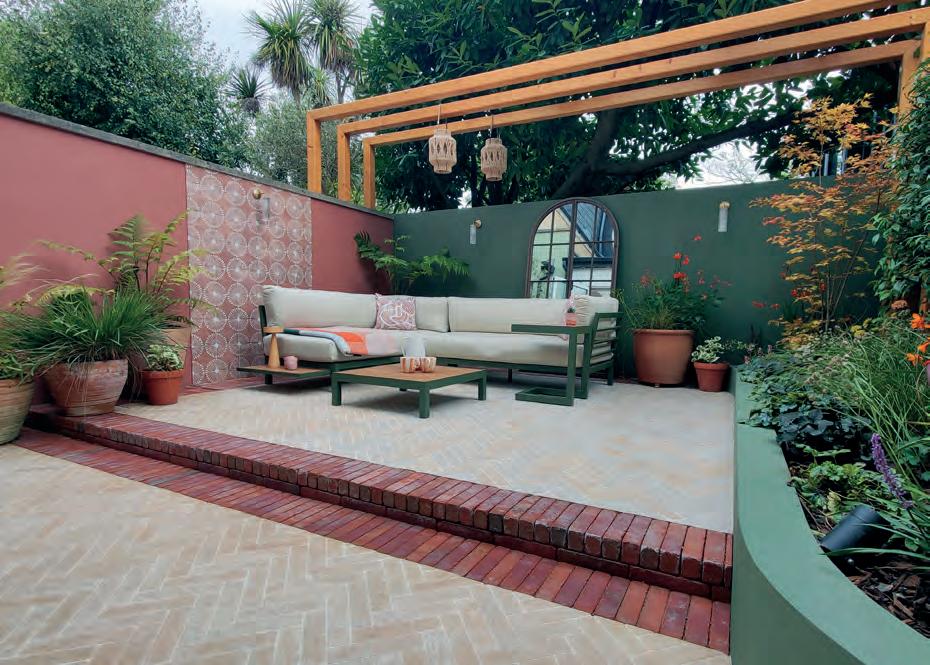


Inspired by the client’s existing decor, Kantalis adopted a bold colour palette of pinks and greens to create a harmonious flow between the interior to the exterior – adding warmth to the space and to distract from the garden’s north facing position.
After repairing the existing wall to the left-hand side, a new layer of render was added and painted in a warm terracotta tone. The decorative tiles were then brought in to “create interest on the wall” –positioned in the centre of each terraced space, leaving space for wall lights to be added in later.
At the rear of the garden, a new wall was established to create a stronger boundary in the space – a bold forest green colour was chosen to not only echo the kitchen’s palette, but to also cool down the space’s warmer colours – “the green complements the Trachelospermum jasminoides and neighbouring Prunus laurocerasus,” creating a “beautiful backdrop” to the planting scheme. This green is carried through to the short-raised beds, as well as the existing shed.
1 Peeking through planting at the cosy seating
2 An overview of the garden
3 From warm terracotta to calming forest green
4 Decorative wall tiles and Cyathea cooperi
5 Structural planting: Crocosmia 'Emily McKenzie'
6 Rudbeckia 'Rudy Mini Yellow Black'
This garden proved that even in a small space, there’s endless potential to create something both natural and contemporary


Kantalis opted for an architectural planting scheme, consisting of primarily shade tolerant species and colourings that unify the space, these include;
• Acer palmatum ‘Summer Gold’, adding height and stucture to the space, with its golden colour tone echoing the new pergola.
• Sphaeropteris cooperi, a tree fern that with time will grow and bring in architectural interest, “without being too imposing” –its slender nature makes it optimal for a smaller space.
• Dr yopteris erythosora, a striking fern which starts off with copperyred fronds when young and slowly matures to dark green, tying in the colour tones of the garden.
• Crocosmia × crocosmiiflora 'Emily McKenzie', Kantalis notes the client’s love for warm colours made crocosmia the “perfect plant to add to the scheme”, bringing height with its arching stems and bright orange flowers.

• Rudbeckia Rudy Mini Yellow Black (Rudy Mini Series), chosen not only for their pompom variety Rudbeckia with masses of double flowers, but also for their colour scheme.
• Carex testacea, chosen to bring in softness and movement to the scheme, this species of grass offers pendulous clumps of attractive orange-bronze to green foliage which will provide changing seasonal intrigue throughout the year.
• Ligularia dentata 'Pandora', Kantalis says this plant was chosen for a multitude of reasons, it offers something “different” to both the clients and the garden. It’s tall-stemmed canopy of orange-yellow daisy-like flowers are suited for shady positions.
• Heucherella 'Tapestry', chosen to complement and offset the Ligularia, this species brings a brightly coloured frontline of foliage to the planting bed.
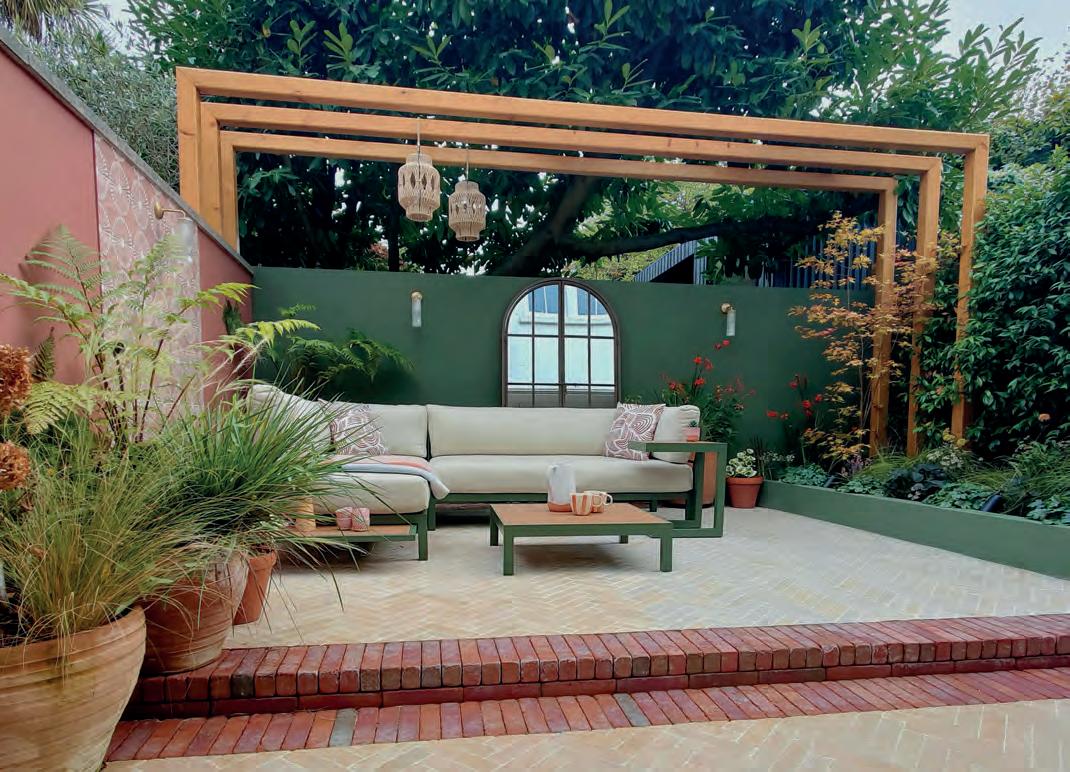
The aim was to treat the space as an ‘outdoor room’, producing a scheme and palette as if it were an interiors project
Utilising existing and new terracotta pots allowed Kantalis to position them throughout the courtyard to help bring in new planting and a “less intrusive garden layout”. She and the team created a bespoke, curved planting bed low to the ground that provided ample space to plant an Acer – also
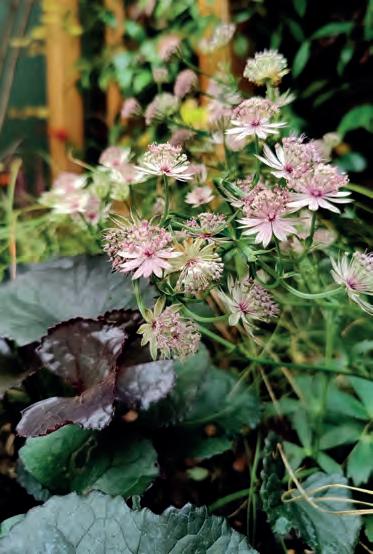
commonly known as a maple tree – to balance out the already established planting.
To tie the design together, Kantalis and the team created a bespoke pergola to add a focal point and height to the garden, framing the space and drawing

the eye upward – “it beautifully frames the neighbouring Prunus laurocerasus, so rather than the species being an imposing entity, as it was before, now with the pergola, it feels as if it’s been blended into the background, allowing your eye to be drawn to the pergola and then the courtyard space itself.”
Ultimately, a functional but aesthetic courtyard that remained true to the client’s tastes was created.
“This garden proved that even in a small space, there’s endless potential to create something both natural and contemporary – size doesn’t and shouldn’t limit the impact!”
7 Elevating the garden with the designed pergola
8 Architectural planting blends structure, texture and colour Photographs ©Katerina Kantalis
Planting
Provender Nursery provendernurseries.co.uk
Clay pavers London Stone londonstone.co.uk
Limestone stackers Mandarin Stone mandarinstone.com
Decorative tiles Ca’Pietra capietra.com
Lighting Corston Lights corston.com
Furniture John Lewis johnlewis.com
Kantalis’ approach to garden design combines the interplay of subtle curves with geometric patterns. Inspired by Mediterranean landscapes her designs integrate permeable materials and emphasise texture and pattern, incorporating vibrant colours. Kantalis’ preference is for the hard landscape elements in a design to be uncomplicated, utilising clean lines to create fluidity and movement within the garden. katerinakantalis.co.uk
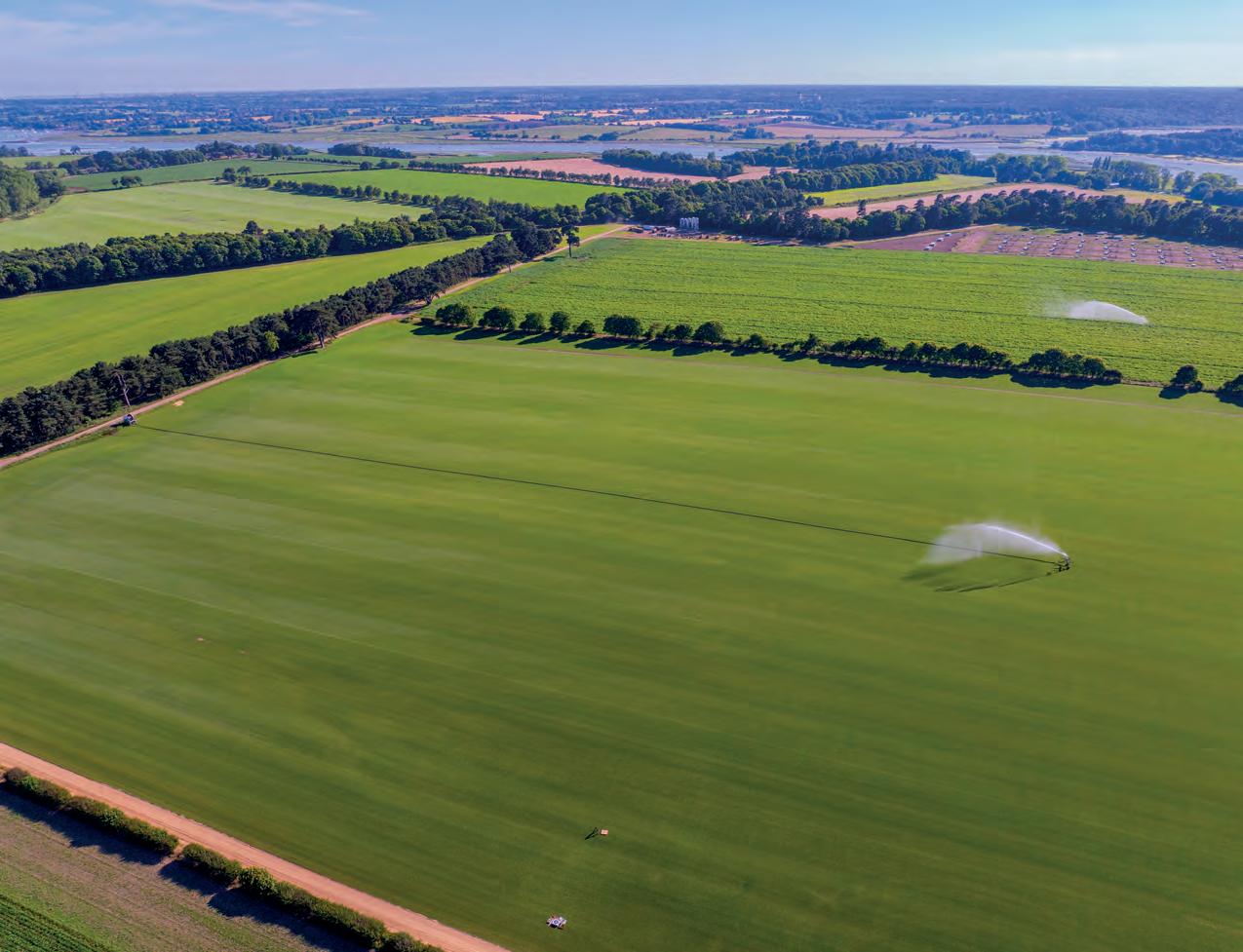
•Vigorous Rooting : Double the depth of other grasses
• Increased Wear Tolerance : Ideal for high footfall areas
• Shade Tolerance
• Always plastic free
• Freshly cut and delivered within 24 hours

Friday 11 July 2025 | 16:30 | De Vere Horsley Estate
Enter the awards or purchase tickets
Will Williams | 01903 959390 will.williams@eljays44.com
Sponsorship opportunities
Jodie Rugg | 01903 959401 jodie.rugg@eljays44.com
Download the entry guide

2025 partners

2025 categories
• Design under £50,000
• Design
£50,000 - £100,000
• Design £100,000 - £250,000
• Build under £50,000
• Build £50,000 - £100,000
• Build £100,000 - £250,000
• Design and Build under £50,000
• Design and Build £50,000 - £100,000
• Design and Build £100,000 - £250,000
• Planting Design under £25,000
• Special Feature under £50,000
• Hard Landscaping under £50,000
• Hard Landscaping £50,000 - £100,000
• Sustainable Garden under £50,000
• Temporary Installation under £50,000
• Community Green Space under £100,000
• Community Green Space £100,00 - £250,000
Project
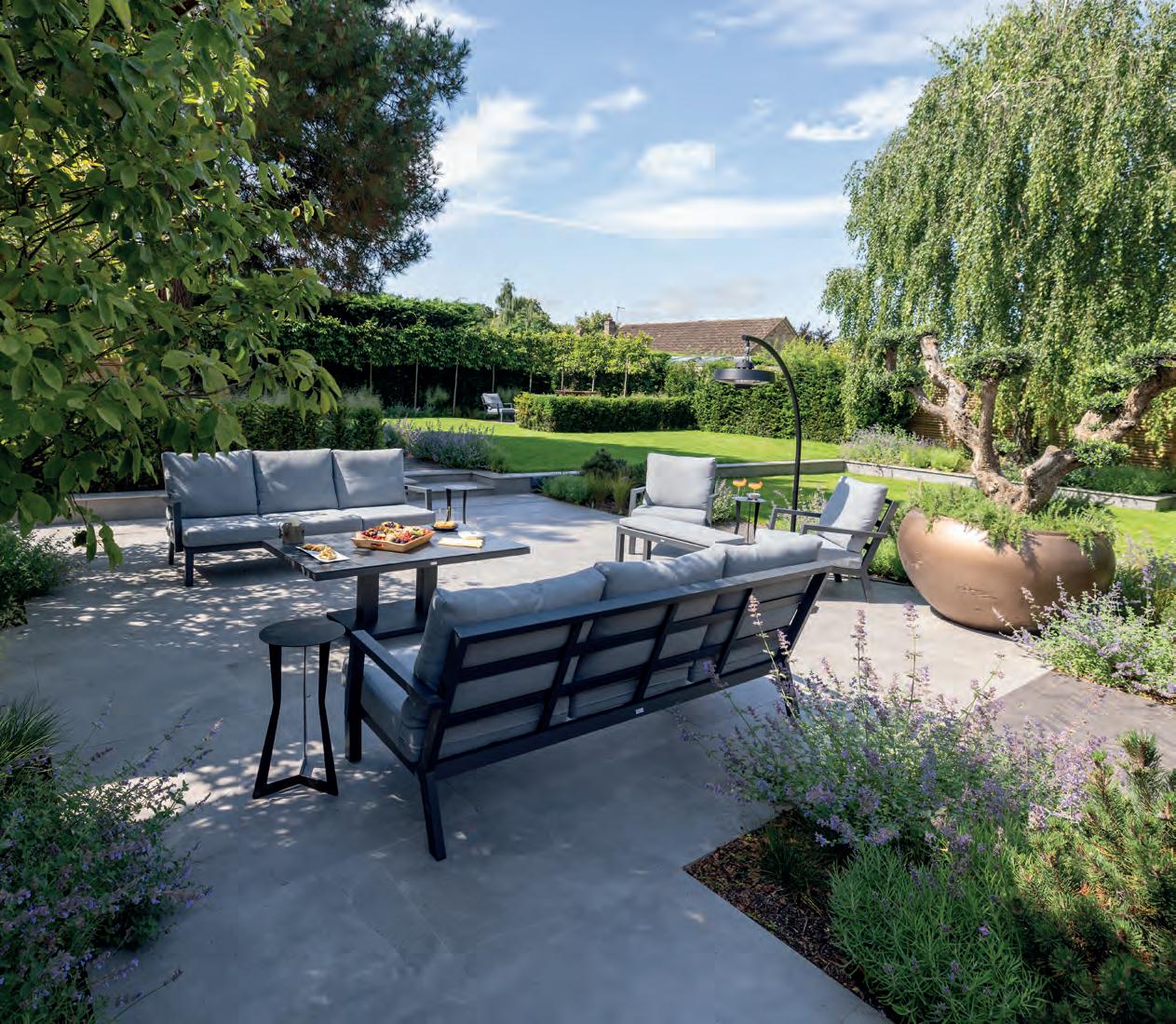
CONSILIUM HORTUS
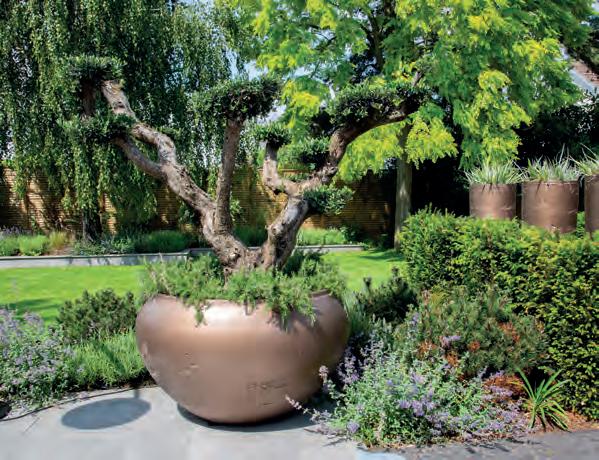
CONTEMPORARY CAMBRIDGE GARDEN 1 Stylish Mediterranean-inspired garden, perfect for relaxation and entertaining 2 Striking sculptural tree in statement planter
The team at Consilium Hortus are no strangers to creating high-end spaces, and this contemporary garden in Cambridge was no exception. The brief called for a multifunctional outdoor space that echoed the modern architecture of the property while maintaining the softer, natural elements of the garden. With a contemporary design already established in the property, Consilium Hortus had the perfect canvas to extend this theme into the garden, creating a cohesive and harmonious flow between the indoor and outdoor environments.
The client desired a garden that would not only serve as a place of beauty but also as a hub for entertainment, dining, cooking, and relaxation. With a design brief that included the creation of several spacious patio areas, which would serve as versatile zones for hosting guests, these patios needed to be large enough to accommodate both intimate family gatherings and larger social events, ensuring flexibility in their use. Pathways were thoughtfully laid out to lead guests naturally from one area to another.
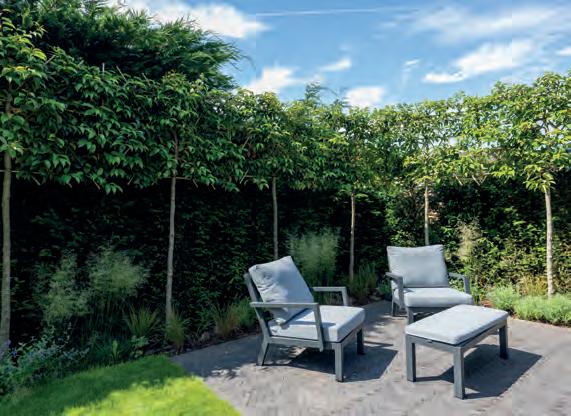
To bring the concept to life, the team developed mood boards that captured the overall aesthetic and ambience of the garden. Consilium Hortus director, Sam Moore, notes how these boards were “instrumental in conveying the desired look and feel”, allowing the client to visualise the finished space, from the materials and planting down to the colours and textures. A key feature requested by the client was the inclusion of a fireplace, which would not only provide warmth during cooler evenings but also act a striking focal point. “The fireplace was designed to complement the modern aesthetic, incorporating clean lines
• Agapanthus 'Charlotte'PBR
• Lavandula
• Calamintha nepeta 'Marvelette Blue'
• Pennisetum advena
• Verbena officinalis
• Salvia officinalis
• Anemanthele lessoniana
• Deschampsia cespitosa
• Pinus sylvestris
• Taxus baccata
• Prunus laurocerasus

and contemporary materials, while also offering a cosy atmosphere that invites conversation and connection,” says Moore. The overall garden layout has been designed to enhance the functionality and visual appeal of the space; “ultimately the goal was to create a garden that offered the clients a space that is as practical as it is visually appealing, perfectly suited to their lifestyle and tastes.”
The client sought to infuse the timeless charm and tranquillity of a Mediterranean landscape, to achieve this vision, a range of plant species were carefully selected to evoke the warm, sun-drenched ambience characteristic of Mediterranean gardens, while
also ensuring that the plants would thrive in the local climate. One of the stand-out features of the planting scheme is the Pinus mugo, a hardy dense pine; its bushy form adds texture and structure to the garden, while its evergreen nature ensures that the garden retains its lush, green appearance year-round, providing a strong visual foundation.
At the heart of the garden also stands a majestic Olea europaea (F), a quintessential symbol of the Mediterranean. “This feature tree not only serves as a striking focal point but also brings an authentic Mediterranean essence to the space,” comments Moore. “It's silvery leaves and gnarled trunk add both


beauty and character, creating a sense of age and permanence that anchors the design.”
To complement the structural elements, Consilium Hortus introduced a variety of flowering plants that contribute to the garden’s colour palette and sensory appeal, including Salvia and Verbena, for their vibrant purple and blue blooms, which bring bursts of colour that attract pollinators, adding life and movement to the space. For ground cover and to enhance the Mediterranean feel, Calamintha was planted – a fragrant herb that releases a pleasant minty aroma when brushed against. Its delicate white flowers further contribute to the garden’s light and airy atmosphere, while also helping to suppress weeds and reduce maintenance.
Ultimately the goal was to create a garden that offered the clients a space that is as practical as it is visually appealing, perfectly suited to their lifestyle and tastes
ensure privacy and create a sense of seclusion; “this evergreen hedge serves to screen the existing fencing, softening the boundaries of the space and enhancing the overall aesthetic. The dense foliage of the Taxus provides an effective barrier, both visually and acoustically, contributing to a peaceful and private retreat.” Moore adds that overall, the planting scheme “successfully captures the essence of a Mediterranean garden, combining beauty, structure, and functionality to create a space that is both inviting and serene”.
3 Private, tranquil garden retreat
4 Natural textures, soft lavender and wooden shed
5 Relaxing entertaining area with view to garden
Mature Taxus hedging was planted around the perimeter of the garden to
6 View of garden and home
7 Tall, textured planters add bold statement


Throughout the project, several periods of heavy rainfall posed a challenge in maintaining the work’s quality as excess moisture can affect everything from stability of the foundations to the handling of materials like soil and concrete. To address this, the team implemented measures to protect the site, including temporary drainage solutions to manage water accumulation. Another obstacle for the team came in the form of accessibility to the garden – with limited entry points to the space posing a challenge. “This restriction meant that every aspect of the project, from the delivery of materials to the movement of machinery, had to be meticulously coordinated.”
Larger materials such as mature trees and paving stones had to be transported in smaller quantities – this with the challenging weather conditions ultimately led to a longer build time. Moore says


despite this, “the experience underscored the importance of adaptability and teamwork, as the success of the project depended on our ability to respond to unforeseen challenges without compromising the client’s vision.”
The garden seen today is the result of a meticulous and collaborative design process that involved close communication and cooperation with the client. “From the initial concepts to the final execution, we worked hand in hand with the client to ensure that their vision was fully realised. It is a testament to the dedication and resilience of everyone involved.”
8 Formal dining area complementing style of home
9 Herringbone brick pattern meets soft lavender
10 Perfect for cozy gatherings and al fresco dining
Consilium Hortus is an Essex-based innovative garden designer team working in East Anglia and London, offering bespoke garden design packages to create stunning gardens that perfectly match the client’s brief and vision. Whether the client needs a design that they wish to implement themselves, or they want a complete garden delivered by the team, Consilium Hortus can help. consiliumhortus.co.uk
REFERENCES
Contractor JPB Landscapes jpblandscapes.co.uk
Paving London Stone londonstone.co.uk
Planting Practical Plants practical-plants.co.uk
Planters Torc Pots torcpots.com
Irrigation Landscapeplus landscapeplus.com







Senior/ContractsManagement
SiteSupervisors/Foreman
Hard&SoftLandscaping
GardenDesigners
InteriorLandscaping
Nursery/GardenCentre
MaintenanceGardeners
HorticultureSales
GroundsMaintenance
SkilledTradespeople
AmenityHorticulture
Labourers&more....

Millboard’s global director on the supplier’s new Modello range
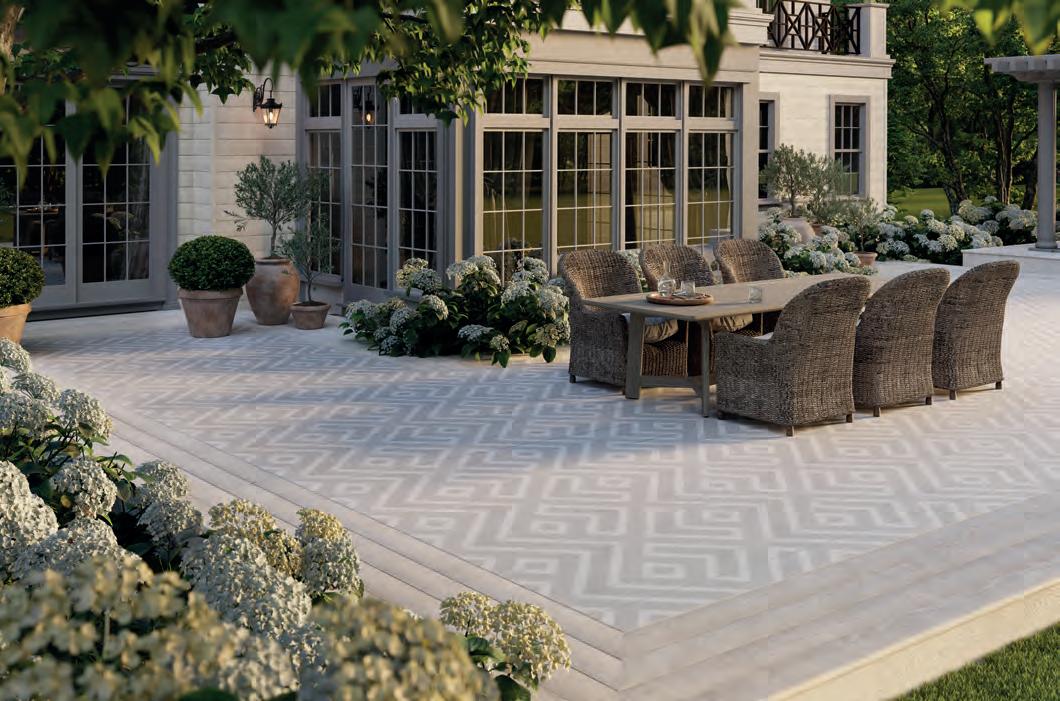

What inspired the new Modello range?
The Modello signature decking range by Millboard was born from a vision to merge innovation with design excellence, redefining outdoor spaces as canvases for creativity and self-expression. As my father, James Douglass, chairman of Millboard, has said: “Modello embodies our passion for pushing boundaries and creating products that inspire. It’s not just decking – it’s a platform for self-expression.”
Inspired by the precision of geometric patterns and the organic fluidity of nature, Modello introduces two distinctive styles: Linear and Contour. The Linear style creates bold, dynamic configurations, while Contour introduces a soft and organic flow to decking design. With the ability to offset boards in various ways, Modello offers over 50 unique patterns, unlocking near-limitless design possibilities. The result? Sophisticated simplicity, making every installation a masterpiece.
Designed for both residential and commercial applications, Modello empowers designers and homeowners alike to create truly one-of-akind outdoor spaces, seamlessly blending aesthetics and durability.
What materials is it made from?
Modello is produced using Millboard’s signature Resin Mineral Composite (RMC), a highly durable material that combines natural minerals bonded with a polymer resin and reinforced with long fibres. Unlike traditional wood or PVC decking, this composition ensures superior performance and longevity and is made with one-third recycled materials.
Designed for both residential and commercial applications, Modello empowers designers and homeowners alike to create truly one-of-a-kind outdoor spaces, seamlessly blending aesthetics and durability
How does Modello perform in different weather conditions?
Like all Millboard products, Modello is engineered to withstand diverse and challenging weather conditions, making it a reliable choice year-round.
• Heat resistance: The unique composition prevents warping or expansion in high temperatures, maintaining its structure even in prolonged sun exposure.
• Rain and moisture: The boards are non-porous, contain zero wood content and are highly resistant to water absorption, preventing rot, swelling, or decay.
• Frost and ice: Modello remains stable even in freezing conditions, with no risk of cracking or splitting due to temperature fluctuations.
• Slip resistance: The Lastane layer and surface texture of each Modello board provide exceptional grip even in wet conditions, significantly reducing the risk of slips.
What colour ways and texture options are available?
Modello is available in a thoughtfully curated palette of 10 colours, designed to suit a variety of designs and preferences, from soft neutrals to bold statement tones. The available shades include Burnt Cedar, Jarrah, Antique Oak, Ebony Grey, Brushed Basalt, Smoked Oak, Limed Oak, Ashwood, Golden Oak, Coppered Oak, each bringing its own unique character and charm to projects.
• Innovative offsetting design: With over 50 pattern configurations, Modello allows for truly unique decking layouts.
• Aesthetic and performance excellence: Millboard products are renowned for their blend of beauty and durability, ensuring both form and function.
• Superior material composition: The use of Resin Mineral Composite, with one third recycled mineral stone, offers a far more durable and stable alternative to wood or PVC.
• Customer-centric approach: Millboard’s dedication to quality and customer satisfaction is at the core of every product, ensuring exceptional advice, aftercare, and long-term value.
Like all Millboard products, Modello is engineered to withstand diverse and challenging weather conditions, making it a reliable choice year-round
With these colour variations and two unique styles – geometric Linear and flowing Contour - Modello provides limitless possibilities for personalisation.
What are the key features of the Modello range?
Modello offers several standout features that set it apart in the decking market:
• Design flexibility: Over 50 pattern options can be created by simply offsetting the boards, offering endless design possibilities.
• Slip-resistant surface: The Lastane layer and surface texture of each board ensures excellent slip resistance, making it safe for high-traffic and wet areas.
• Highly durable and low maintenance: Unlike wood, Modello does not require staining, sealing, or sanding.
• Weatherproof: Resistant to UV, moisture, frost, and heat, ensuring longevity without degradation.
• Lightweight yet strong: The resin mineral composite boards are robust yet easy to handle and install.
What matching accessories come with the range?
Modello is designed to be complemented by a full range of matching accessories, ensuring a seamless and professional finish. These include:
• Enhanced grain boards
• Bullnose and flexible edgings
• Fascia boards
• Durafix fixings
Modello is specifically designed to coordinate with our standard colour range of the Millboard Enhanced Grain decking collection.* (*Please note: Due to the unique design of Modello boards, slight visual variations in colour may occur).
What sets Modello apart in the current market?
Modello is a first-of-its-kind innovation in the decking industry, offering unparalleled design possibilities. Its key differentiators include:
How has Millboard secured its current position in the market?
Millboard has built its reputation on the pillars of quality, innovation, sustainability, and customer satisfaction. The company’s commitment to providing exceptional products is evident through:
• Unmatched quality and performance: Millboard products deliver outstanding durability, aesthetic appeal, and resistance to the elements.
• Commitment to sustainability: The company integrates sustainable practices throughout its operations, from using certified recycled materials to harnessing renewable energy in manufacturing.
• A customer-first approach: Exceptional customer service and satisfaction drive Millboard’s continuous innovation.
• Industry leadership: As innovators in composite decking, Millboard remains at the forefront of technological advancements in the field.
• British designed and manufactured: Millboard remains a proud third-generation, UK based family business, committed to upholding its legacy of excellence and craftsmanship.
For more information, visit millboard.com/modello.



Project value
£1.7m
Build time
7 months
Size of project
Approx. 2 acres

Greenwich Park, part of Maritime Greenwich UNESCO World Heritage Site, has long been a place where history, nature, and culture meet. Home to the Prime Meridian Line, the Royal Observatory, and the iconic General Wolfe Statue views, this Grade I Listed landscape is not just a park, it is a living archive of 590 years of heritage. However, as visitor numbers grew and time took its toll, the park began to show the strain. The 17th-century landscape had become eroded, the trees lining its historic avenues were failing, and its infrastructure was under increasing pressure.
Recognising the need for restoration, the four-year, £12m Greenwich Park Revealed project was launched to restore, protect, share, and enhance this historic natural landscape for future generations. The charity, which manages London's eight Royal Parks, has funded the project alongside a grant from the ‘Parks for People’ programme, funded by The National Lottery Heritage Fund and Community Fund, thanks to National Lottery players.
Blakedown Landscapes was entrusted
with four critical work packages as part of Phase 2: the Grand Ascent and Parterre Banks, the General Wolfe Public Realm, the Pavilion Café, and Blackheath Gate. Each presented unique challenges, demanding both technical expertise and a respect for the park’s history and ecological significance.
From tender to construction, Blakedown worked closely with the client, The Royal Parks charity, and design team to ensure functionality, providing expertise and guidance that helped the project evolve in response to challenges.
Throughout the project, Blakedown collaborated with the client and project team to navigate multiple adjustments to the original design, driven by onsite challenges. By
working together to find effective solutions, it ensured a smooth and efficient construction process, leading to a successful outcome. Supporting and protecting the parks rare habitats was key and involved working closely with The Royal Parks’ ecology experts throughout.
1 The transformed public realm surrounding the General Wolfe Statue
2 York stone paving, General Wolfe Statue

The Grand Ascent
One of the most ambitious aspects of Blakedown’s scope was the restoration of the Grand Ascent, a feature central to the 17th-century formal landscape. This task required not only an understanding of the historical remnants and their archaeological value but also an innovative approach to modern challenges. Using historic drawings as a blueprint, Blakedown undertook the complex task of re-profiling the slopes, stabilising the banks, and planting a new avenue of trees.
The scale of the earthworks was considerable, requiring over 1,500 dumper loads of soil to be relocated. Preserving the integrity of the site while achieving this was a delicate balancing act.
Additionally, Blakedown collaborated closely with The Royal Parks’ soil scientist to develop a strategy to prevent compaction and maintain soil integrity. This included rotavating the vegetation layer before separating and storing topsoil to ensure it could be respread. This adaptive approach was not only approved by the client’s soil consultant but also proved to be a cost-effective solution, aligning with environmental sustainability
The Parterre Banks
The restoration of the Parterre Banks in the Queen’s Field was another key aspect of the project that required a blend of historical knowledge and technical expertise. Years of heavy foot traffic had eroded the banks, necessitating careful re-definition and restoration. The large cut-and-fill operation required the relocation of around 5,000m3 of earth to reinstate the original form of the banks.
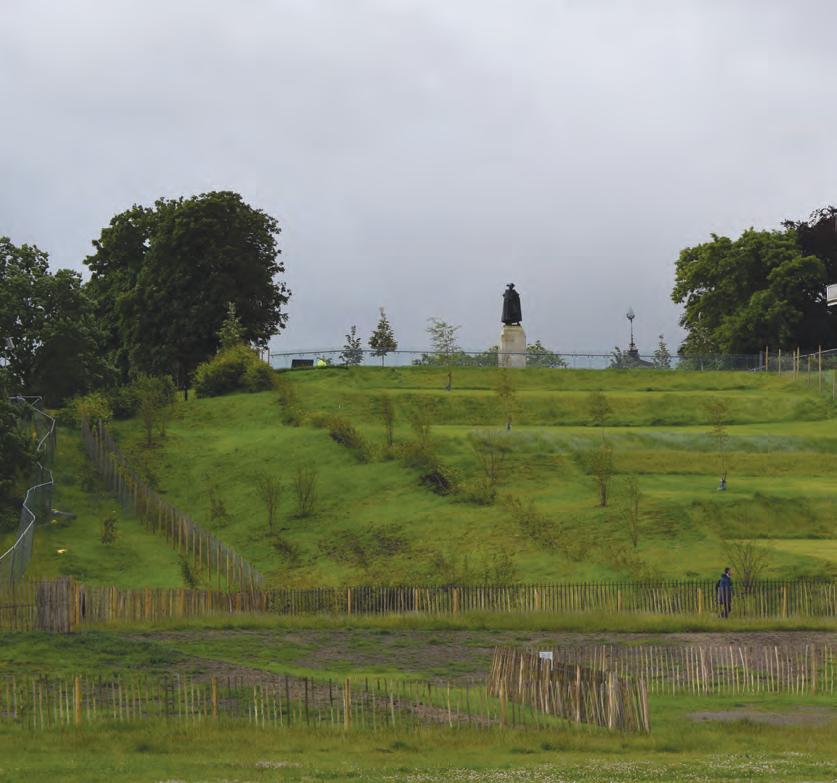
Achieving the correct lines and levels was a precise operation. While modern lasers and GPS technology played a role, Blakedown’s experienced operatives also relied on their trained eyes to ensure a natural, historically accurate finish.
A particularly innovative challenge arose when the original specification stipulated the reuse of 7,000m2 of existing turf for the Parterre Banks. Blakedown recognised that this approach would not achieve the desired outcome, presenting logistical issues with turf
storage and maintenance and in response, proposed an alternative solution: rotavating the seed bed into the topsoil layer and storing it to be respread later. Additionally, Blakedown worked closely with the supplier to develop a unique seed blend that matched the existing turf. This innovative solution not only successfully reused the surface but also saved costs.
General Wolfe Statue public realm
The transformation of the public realm around the Grade II listed General Wolfe statue


required a blend of functionality, aesthetics, and sustainability. A major innovation was the incorporation of a sophisticated attenuation sub-system – permeable paving over a sustainable urban drainage system – beneath the central section of the platform. Blakedown worked closely with the supplier to develop a bespoke jointing mix to accommodate water volumes effectively. The design includes a series of geo cellular crates beneath the surface to create an underground void to detain stormwater effectively.
Additionally, complex hard landscaping was carried out to extend the area in front of the statue - preserving 600m2 of Yorkstone while integrating over 600m2 of new setts and paving to create a seamless blend of old and new. The viewing platform's steps were refurbished to ensure safe access and new retaining and seating walls were constructed from Portland stone finished with Ashlar cladding. To finish, a glass balustrade was added along the platform’s edge, balancing safety with uninterrupted views
The Pavilion Café is a popular area within Greenwich Park, and Blakedown’s work here focused on improving the visitor experience. New seating areas, resurfaced pathways, and ornamental planting were introduced to make the space more inviting. Additionally,
power and water services were extended to the northern paved area, ensuring the café could better serve the park’s growing number of visitors
3 The restored Grand Ascent
4 The General Wolfe viewing platform with glass balustrade giving uninterrupted views
5 New lime tree avenues at General Wolfe Statue
6 The Pavilion Café

Meanwhile, Blackheath Gate, a major entrance to the park, was given a refreshed landscape treatment to welcome visitors to the park. Existing hard standing was removed through hand excavation to protect retained trees, kerbs were realigned, and additional cycle stands were installed to promote sustainable transport. The existing tree lines were extended up to the entrance creating more green space. These
interventions had a significant impact on improving access while reinforcing the grandeur of Blackheath Gate’s entrance.
Throughout the project, Blakedown faced a range of challenges that required swift responses, technical expertise, and collaboration. For example, the project faced a key challenge when heavy rainfall threatened to


delay progress. The initial stabilisation method for the Grand Ascent of hydroseeding was rendered ineffective by severe soil erosion caused by the intense weather. In response, and recognising the need for a more resilient solution, Blakedown, in discussion with the client, agreed the use of turf instead of hydroseeding. This decision proved successful, providing long-term stability and ensuring the Grand Ascent’s structural integrity for generations. To further reinforce the structure, Geogrid stabilisation and Geotextile Anchors were installed within anchor trenches spanning the top, middle, and bottom sections of the steps.
Other challenges included sourcing the correct ericaceous soil for the Parterre Banks which proved difficult, as many suppliers were unable to meet the required specifications. But through close collaboration with Bury Hill, Blakedown was able to source the perfect soil blend, tailored to the park’s needs.
Taking into account the ecology of the historic landscape was vital and Blakedown worked with The Royal Park charity’s biodiversity team to ensure the conservation of species ahead of works and ensure no damage to the rare habitat.
Archaeology also played a significant role in the
project, with each excavation area requiring careful monitoring to protect the site’s historical integrity. Blakedown took a proactive approach, working with The Royal Parks’ in-house archaeologist and asking for him to be on-site more frequently than initially planned, which allowed for timely assessments and reduced the need for extensive earth stockpiles. Both ecology and archaeology considerations ensured there was no potential damage to any of the history underneath the landscape.
A lasting legacy
Greenwich Park Revealed is more than a restoration project; it is a commitment to preserving a landscape of historical, cultural, and ecological significance. The successful delivery of these works reflects the expertise, adaptability, and collaborative spirit of everyone involved. By balancing heritage conservation with modern landscape techniques, Blakedown has helped to ensure that Greenwich Park remains an enduring landmark for future generations to enjoy.
7 Perimeter walls – concrete block with steel fixings
8 Top soil handling – Grand Ascent
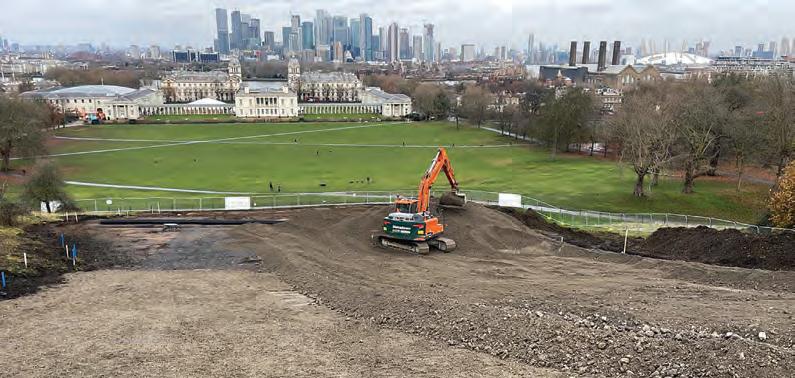
Blakedown Landscapes is an award-winning landscaping and civil engineering specialist delivering high quality projects throughout the UK. With over five decades of experience, its extensive knowledge spans all sectors including local authorities, royal parks, commercial developers, educational facilities and historic park restorations. Its team of highly skilled in-house experts works collaboratively with clients offering best practice advice and innovative value engineering solutions to ensure the optimal outcome for every project. blakedown.co.uk
Client and landscape architect The Royal Parks royalparks.org.uk
Tree cells GreenBlue Urban greenblue.com/gb
Ground anchors Geosynthetics geosyn.co.uk
Aggregates Day Group daygroup.co.uk
Drainage Burdens burdens.co.uk
Paving Johnsons Wellfield johnsons-wellfield.co.uk
Soils
Bury Hill Landscape Supplies buryhilltopsoil andlogs.co.uk





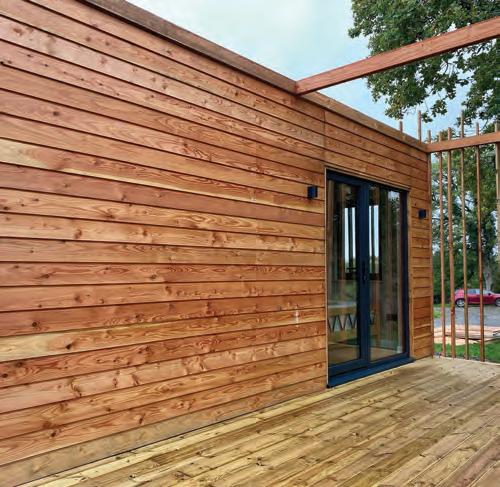


MEDITE TRICOYA EXTREME provides outstanding durability and dimensional stability


For professional joiners and fitters, selecting the right material is crucial for delivering high-quality, long-lasting outdoor furniture. Clients expect durability, minimal maintenance and precision craftsmanship – but not all materials perform equally in outdoor settings.
To give outdoor furniture an increased lifespan, MEDITE TRICOYA EXTREME (MTX) from MEDITE SMARTPLY provides outstanding durability and dimensional stability. To create its extremely durable panels, MEDITE SMARTPLY uses advanced manufacturing technology with acetylated wood fibre, which results in panels that can be used in applications where other woodbased panels are not suitable.
MEDITE TRICOYA EXTREME panels come with a 50-year guarantee above ground and 25 years in-ground. Independent testing by BRE confirmed an expected service life of 60 years for exterior use, meaning joiners and fitters can confidently assure clients that their outdoor furniture and joinery will remain structurally
sound and visually appealing for decades. These characteristics allow it to be used in a wide range of bespoke outdoor applications, including sculptures, garden furniture and outdoor kitchens. MTX serves as a great and more flexible alternative for applications that were once limited to materials like concrete, plastics or metals. For joiners and fitters, working with MTX is as straightforward as using standard MDF, with the added benefit of outstanding durability in exterior applications. The panels can be cut, shaped and routed with ease, allowing for intricate detailing without the risk of splintering or inconsistencies found in natural wood. Its exceptional dimensional stability means that swelling and shrinking are minimised, ensuring precise, tight-fitting joins and a flawless finish every time. This eliminates common issues such as warping, cracking or paint deterioration, reducing callbacks and maintenance concerns for professionals. Additionally, MTX withstands exposure to moisture, humidity and salt, making it ideal for seaside installations and other demanding environments.
The ultimate display of landscape designer creativity takes place annually at the RHS Chelsea Flower Show. At the 2022 show, MEDITE SMARTPLY partnered with renowned designer Sarah Eberle to feature a centrepiece crafted with MEDITE TRICOYA EXTREME. The project entitled the ‘Building the Future’ garden received the Gold and Best Construction Award (Show Garden).

The MTX centrepiece, inspired by natural vertical rock strata, combines aesthetic appeal with environmental resilience, highlighting the versatility of wood panels in challenging weather conditions. Going beyond being an eye-catching and stunning installation, the MTX centrepiece has been given a new lease of life as the entirety of the MEDITE SMARTPLY Building the Future Garden has been reused, truly living up to its name. The relocation of the impressive garden structure, featuring MEDITE TRICOYA EXTREME and SMARTPLY STRONGDECK, forms part of MEDITE SMARTPLY’s legacy campaign. This further demonstrates the company’s commitment to being fully sustainable and promoting circularity.
This year, MTX will once again take part in the Chelsea Flower Show, featured in several major projects. This provides joiners and fitters with the perfect opportunity to see the material in action and understand its versatility in outdoor applications.
To find out more about MEDITE TRICOYA EXTREME, visit: https://mdfosb.com/en/products/medite-tricoya-extreme
From soil health to visual appeal, these bark and mulch options are key for creating and maintaining green spaces
Contract Ornamental Bark
Price: £45.00 - £55.00 / m³ (full loads)
£75.00 - £85.00 / bulk bag (full loads)

Contract Ornamental Bark is a highquality blend of conifer and pine bark, ideal for both professional and domestic landscaping. It enhances appearance, supports soil health, and provides practical benefits for long-term use. This versatile mulch is FSC-certified, ensuring a sustainable and responsible supply chain.
• FSC-certified, ensuring a sustainable and responsible supply chain.
• Appearance is a mix of 15-35mm chippings of conifer and pine tree bark.
• Helps retain soil moisture by reducing water evaporation, ensuring plants stay hydrated, especially during dry periods.
• Protects soil from erosion caused by wind and rain, making it especially effective on slopes and in areas with heavy rainfall.
• The bark layer blocks sunlight, preventing weed seeds from germinating and reducing the need for weeding.
How does it support positive soil health?
Contract Ornamental Bark is a versatile accompaniment to our specialist soil mixes. A layer on top helps protect and improve soil structure over time as the bark naturally decomposes. This slow breakdown process gradually releases nutrients, It offers a lowmaintenance solution that supports long-term vitality. bourneamenity.co.uk

Melcourt Spruce
Ornamental
Price: Varies depending on haulage distance and bag type
A popular, highperformance bark mulch suitable for a wide range of garden and professional landscape applications, including prestigious sites, car parks, superstores, business parks, tubs and planters.
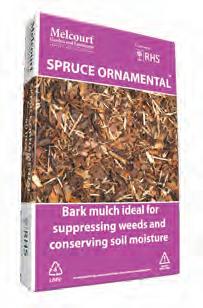
• British mixed-conifer bark mulch with a particle size range 5 to 35mm
• Absence of fines gives excellent protection against air-borne weed seeds
• Long effective service life of two years plus
• FSC certified indicating that it’s sustainably sourced
• Naturally acidic, free-flowing and easy to handle

How does it support positive soil health?
Being made from a pure mixed-conifer bark, Melcourt Spruce Ornamental helps to support soil health in many ways. Applied on the surface of the soil, it helps to retain moisture in the root zone and in doing so helps to support a thriving soil macro and microflora and fauna. Spruce Ornamental is hard-wearing but will eventually break down to give an organic matter boost to the soil below with all the well-known benefits which that confers. melcourt.co.uk
Landscaping Bark Bulk Bag
Price: Dependant
Rolawn Landscaping Bark is a natural, nutrient-rich choice designed to support soil health whilst enhancing garden aesthetics. Responsibly sourced from forestry woodchip and free from chemical contaminants, it’s ideal for mulching beds, borders, pathways, and pots – providing a practical, sustainable solution for landscapers and gardeners alike.

• Inhibits weed growth and helps retain moisture
• Attractive mid-dark brown appearance
• Responsibly sourced bark
• Suitable for mulching beds, borders, pathways and pots
• Free flowing and easy to barrow and rake out rolawn.co.uk


















Be it for aesthetic, security or noise reduction, hedging can play a vital role in any outdoor space


Prunus lus. Angustifolia
Price: £51 ex nursery
A small leaved evergreen which trims up to a crisp form. Great for hedging with dark green leaves and a reddish tinge to the younger stems.
HUSQVARNA
Husqvarna 542i XP® G
Battery chainsaw
Price: £809

• Glossy dark green leaves
• Reddish tinge to younger stems
• Compact growing compared to other laurels
• Easy to maintain at around 120cm tall
• High class aesthetic readyhedgeltd.com

The world’s first professional battery chainsaw with a clutch and handle heating, providing superb capacity and improved winter grip. This 36V battery chainsaw is a highly efficient tool for urban tree care workers and arborist ground crews who also work in cold and damp weather conditions. The clutch provides petrol-like control and response, with all the benefits of cordless electric power. The X-CUT™ chain deliver fast cuts in every application.
• The centrifugal clutch provides kick-start energy at the start
• Heated handles – convenient to switch on/off at the keypad
• 30-40cm bar length
• 24 m/s chain speed / 40cc petrol equivalent
• IPx4 Rated husqvarna.com/uk

Carpinus betulus (Hornbeam)
Price: Bareroot plants start at 45p for 20/40cm in height and Rootball plants upward of 3M at £55
A native favourite with UK provenance 405. Available from bear root hedging through to rootball containers pleached. Also grown as specimen trees at 25/30cm girth where specified on plans.

Grown from UK seed and in high demand throughout the year. It is tolerant of most soil types and a natural successor to beech which can be tricky in certain soils.
• Highly tolerant
• Native species
• Resistant to pest and disease
• Nesting bird friendly
• Holds its foliage throughout the year wyevalenurseries.co.uk
Straight
Price: RRP
£36.46
Bulldog Pro’s newest hedge shears designed to deliver unparalleled performance and comfort. With lightweight handles, soft grips, the carbon steel cutting blades ensure smooth clean cuts with minimal resistance. The innovative cutting action reduces effort and maximises efficiency, giving you perfect hedges every time.
• Lightweight, soft grip handles
• Carbon steel bypass cutting blade
• Teflon non-stick coating
• Safety lock mechanism
• Creates clean, straight edges bulldogprotools.com










• Keep jointing in cold (> 3oC)
• Keep jointing in wet weather
• No delays - No waiting to joint
• No concerns over water in joints
• No waiting to clean off
• No washboy required
• No haze & No efflorescence +
• Easy wet-slurry application
• Very high flow & self-compacting
• No tooling or finishing required
• Fast curing & hardening +
• No shrinkage cracks
• Highest joint performance
• Optimum strengths & flexibility
• Fully resistant to traffic, de-icing salts, and jet-washing

Draco Grills Outdoor
Kitchen Stainless Steel Cleaner and Protection Kit
Price: £49.99
This cleaning kit is a convenient and comprehensive solution to keep your Draco Grills stainless steel barbecue in top shape. With the included rust remover and polishing cloths, you can easily clean, protect, and restore the shine of your grill.
• Includes rust remover and cleaner, protector, scrubbing pads, and cloths
• Eco-friendly
• Two-step cleaning process
• Simple to use dracogrills.co.uk

Keep your outdoor spaces looking fresh with these cleaning and aftercare products

Classic Jeyes Fluid Price: £4.99 - £44.99
The classic Jeyes Fluid is back with its original formula, a product with over 145 years of heritage, and a holder of the Royal Warrant since 1896. Jeyes Fluid is an established outdoor disinfectant and is a versatile solution for maintaining hygiene and cleanliness in outdoor spaces.

• Cleans outdoor spaces including patios, driveways, and plant pots.
• Removes mould and algae
• Can be used to clean tools
• Deodorises and cleans outdoor drains jeyesfluid.co.uk
BULLDOG PRO
Straight Hedge Shears
Bulldog Pro’s newest hedge shears are designed to deliver unparalleled performance and comfort. With lightweight handles, soft grips, the carbon steel cutting blades ensure smooth clean cuts with minimal resistance. The innovative cutting action reduces effort and maximises efficiency.
• Lightweight, soft grip handles
• Carbon steel bypass cutting blade bulldogprotools.com

Automower® 560 EPOS™
Price: £6,099
Tailored for facilities management, this model is optimised for maximum uptime with remote start options, providing enhanced operational flexibility. It also features wire-free mowing with selectable patterns, and a flexible front wheel axle making it a reliable choice for hilly, large, and complex landscapes.
• Up to 12,000 m² (in 48h) (3 acres)
• Cut height 20-60 mm (0.8-2.4”)

• 50% slope performance
• 40W cutting motor husqvarna.com/uk
Talasey’s Wood Deck Cleaner Price: Dependent
Talasey’s Wood Deck Cleaner is a high-performance formula designed to remove organic growth from wood decking, fencing, garden furniture and panels. It eliminates algae, moss, leaf stains and soiling while being fast-acting and easy to apply. Safe for all wood surfaces, it contains no solvents, acids or caustic soda, ensuring no damage or discolouration.
• Effectively removes organic growth and staining from wooden decking
• Very easy to use and revives and brightens weather-beaten exteriors
• Fast-acting – the results can be seen in hours
• Contains no solvents, acids or caustic soda – ensuring no damage/discolouration
• A waterborne product with a high penetrative power talasey.co.uk












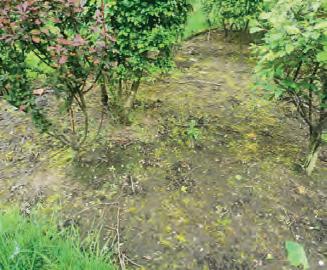
Having spent many years as a landscape maintenance contractor, I understand the day-today challenges faced by these companies – vague specifications, unrealistic expectations, and aggressive business practices, to name a few. And that’s not to mention the stubborn industry skills gap, making finding and retaining staff increasingly difficult.
The project is the product of direct experience with the daily challenges experienced by contractors, and is intended as a collaborative tool designed to benefit everyone involved in landscape maintenance
But let’s make no mistake, landscape maintenance contractors are tasked with looking after our most important green infrastructure: the spaces interacted with by most of the population daily – on housing estates, supermarket car parks, business parks and all our ‘in-between’ green spaces. Research shows that the likes of municipal parks are disproportionately visited by middle class white people (Snaith, 2015), which means that the proven benefits of quality green infrastructure (Soga et al., 2017) are mainly delivered through our more utilitarian spaces. These landscapes could not be more important.
The Green Standard project – a free, straightforward, good quality, generic grounds maintenance specification – is borne

from my research for the Master of Horticulture (RHS) award. At the core of my research was an investigation into the fundamental communication problems which result in: property managers procuring maintenance services with limited horticultural knowledge; landscape architects creating designs but rarely influencing long-term maintenance specifications; and contractors getting caught in the middle, trying to balance commercial viability with plant health.
The Green Standard aims to represent a practical response to these challenges. It is not an academic exercise or regulatory imposition, nor is it a product of research by academics with limited field experience.
The project is the product of direct experience with the daily challenges experienced by contractors, and is intended as a collaborative tool designed to benefit everyone involved in landscape maintenance – especially contractors, who currently bear the brunt of these industry disconnects in the short term, and wider society that faces the consequences in the long term.
• Clearer tendering: providing a level playing field by offering a standardised specification. Being asked at the tendering stage for additional input on a job-by-job basis is not good enough.
• Client education: helping educate clients about what constitutes proper maintenance, reducing unrealistic expectations.
• Client education: explaining aspirational best practice – describing, for example, the benefits of reduced pesticide use, but explaining the commercial implications of doing so, and demonstrating a route map for reducing pesticides in a practical way.
• Client education: introducing the idea that effective maintenance respects the dynamic nature of living landscapes, rather than vainly attempting to preserve static pictures of perfection.
• Dispute resolution: providing clear standards that can reduce disagreements about what falls within contract scope. Current problematic phrases such as ‘weed free’ simply motivate over-spraying, and leave contractors open to unfair treatment.
• Staff training: providing a training reference for maintenance teams, helping address the industry skills gap.
• Quality recognition: providing a recognised quality benchmark.
• Reduced liability: helping protect contractors from being blamed for plant failures caused by design or installation issues.

The goal is to provide a simple, practical tool that makes everyone's job easier while improving landscape quality

Unlike other specifications, The Green Standard will combine horticultural expertise with commercial pragmatism, it will not be expensive nor difficult to source.
• Best practice environmental horticulture (Cameron & Hitchmough, 2016), recognising the commercial reality of day-to-day maintenance.
• Adaptive yet simple specification structuring – recognising the differing needs of landscapes depending on their level of establishment.
• Soil management protocols: prioritising annual mulching over annual cultivation of soil in flowerbeds – improving aesthetics, visibly demonstrating care to the tenants and residents, making maintenance easier and increasing biodiversity.
• Pragmatic pruning guidelines: acknowledging the challenges of ‘block pruning’ and suggesting creative solutions such as different pruning zones within sites.
• Plant replacement parameters: clear requirements for annual gap planting, and the need for successional planting on older sites.
• Benchmarking: objective ways to assess maintenance quality that don't require specialist knowledge, protecting contractors from subjective criticism.
• Additional works: transparent mechanisms for identifying and pricing necessary work outside regular maintenance.


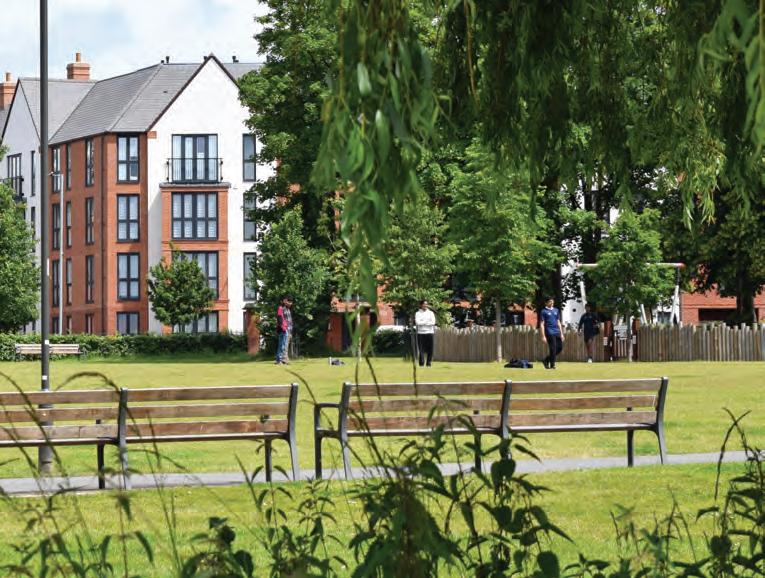
BODIES: TIME TO STEP UP
For The Green Standard to achieve maximum impact, our industry bodies must take a leading role in its distribution and promotion. Following on from a number of positive conversations with industry representatives, I look forward to the day when organisations like BALI, APL, Landscape Institute, Property Managers Association, and the Institute of Workplace and Facilities Management can advertise The Green Standard and make the document available to anyone who wants it – free of charge.
The Green Standard needs to reach beyond our industry echo chamber – if you’re reading this article, you’re likely already convinced of the need for real, effective change. Getting The Green Standard directly into the hands of clients – property managers, facilities managers, housing associations, and commercial landlords – is the critical next step. These are the people who use the specifications to award contracts, making them the ultimate agents of change.
©Jun Huang/Shutterstock.com
The Green Standard will be freely available later this year – it's designed to be straightforward and implementable without requiring the clients to be horticulturally knowledgeable. Initially, it will be available at https://www.tomangel.co.uk/ thegreenstandard, and it is intended that it will be made available through other organisations within the horticultural, landscape architecture, facilities management and property management industries in the future. The goal isn't to create more paperwork, pay lip service, or to continue the conversation within an echo chamber. The goal is to provide a simple, practical tool that makes everyone's job easier while improving landscape quality.
Getting The Green Standard directly into the hands of clients – property managers, facilities managers, housing associations, and commercial landlords –is the critical next step
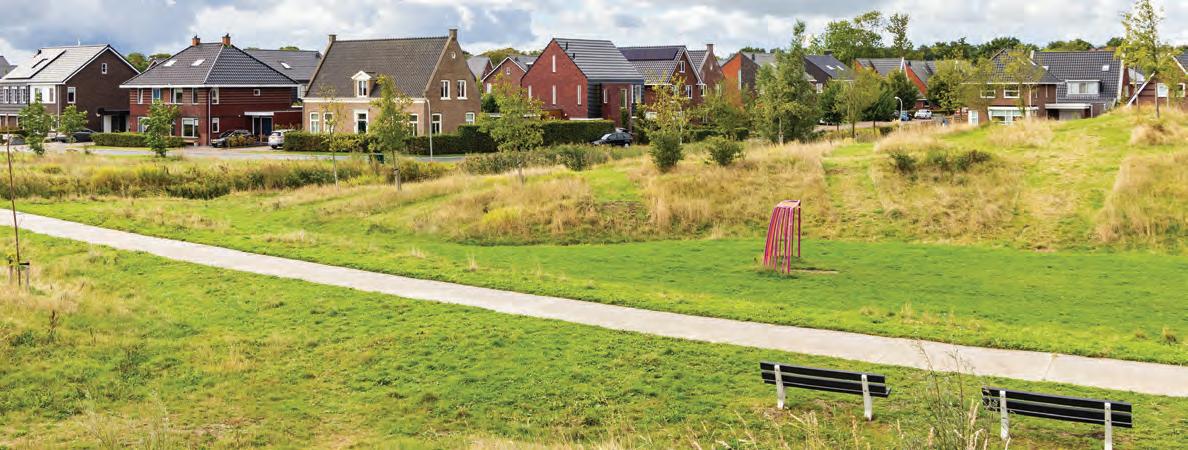

As The Green Standard moves toward completion, there are several ways you can contribute to its success:
• Share your expertise: email me directly at greenstandard@tomangel.co.uk to explain specific maintenance challenges you've encountered, and how The Green Standard might address them.
• Challenge your industry body: contact your professional organisation and ask what they're doing to support The Green Standard. Encourage them to participate in its promotion and commit to distributing it to their client-side contacts.
• Identify client connections: consider which of your clients might benefit from The Green Standard and would be willing to provide feedback during its development.
• Spread the word: share information about The Green Standard with colleagues and on social media.
• Commit to implementation: when The Green Standard is released, speak to your clients about it and ask if you can use it for their projects.
• Sponsorship: an opportunity to help us give The Green Standard its own website, and also send hard copies out to potential clients all over the UK.
The Green Standard represents a significant opportunity to address long-standing issues in the maintenance of our green infrastructure, helping to bridge communication gaps and provide a common reference point. By working together, we can provide an industry-endorsed specification, trusted by all stakeholders, and making a tangible, visible difference.
The Green Standard represents a significant opportunity to address long-standing issues in the maintenance of our green infrastructure
References
Cameron, R., & Hitchmough, J. (2016). Environmental Horticulture (First ed.). Wallingford: CABI. Snaith, D. (2015). The Queen Elizabeth Olympic Park: Whose Values, Whose Benefits?
Soga, M., Gaston, K. J., & Yamaurac, Y. (2017).
Gardening is beneficial for health: A meta-analysis. Science Direct, 5, 92-99.

Tom Angel is a Chartered Horticulturist, Master of Horticulture (RHS), former branch chairman of the Chartered Institute of Horticulture, and worked previously as a landscape maintenance contractor. He now works across the UK as a landscape designer and horticultural consultant. For more information on The Green Standard or to contribute to its development, email greenstandard@tomangel.co.uk tomangel.co.uk
















Pro Landscaper visited Boom and Bonheur’s sites across the Netherlands and Germany to see for itself the quality of its wide selection of trees

The nursery will be celebrating its 130th anniversary this year – and it’s got a lot to celebrate. The quality trees for which it has become known can be seen leading up to the iconic London Eye or lining the historical Straße des 17. Juni in Berlin, for instance. The nursery now spans around 660ha of open land across Germany, the Netherlands and France, with a team of more than 140 people taking care of it.
But there are plans to grow further still, be that expanding its reach into existing markets such as the UK and exploring new opportunities in the Middle East, moving into new headquarters next year, or focusing on digitalisation to move forward the business and make it more efficient.
The company was first founded in the Lower Rhine region of Germany by the Lappen family in 1895. It was called Lappen Baumschule – ‘baumschule’ meaning ‘tree nursery’ in Germany – and would adapt its name to the language of the country that it was selling into, becoming Lappen Tree Nursery for the UK market.
What started as a small nursery gradually became bigger and bigger through generation after generation of the Lappen family, especially under Dieter Lappen, who took over its management in 1968.
“He was the last generation here, and the company became a really big international player in those times,” says Martien Mantje, managing director of Boom & Bonheur, the Dutch arm of Baum & Bonheur. “We were doing a lot in Russia, which was really developing. France was always important, and the German market was around one third of the total revenue. So, we became a major player in Europe.”
Under Dieter Lappen, the nursery’s workforce surpassed 100. But the company began to struggle financially following a downturn in the market and it fell into

insolvency in 2016. The Lappen family tried to keep the nursery in the family, but the court appointed an administrator to manage the company.
For five years, Lappen Baumschule remained for sale. That’s until it sold trees to Peter Overlack, who was leading his family company, Oqema, a chemical distributor in Germany. He’d bought the trees for his castle in France and wondered how he could get involved in the nursery. Within 14 days, it belonged to him and his siblings, Anne and Eva.
This kickstarted a new chapter for the company, and it changed its name to reflect this, becoming Baum & Bonheur in Germany and Boom & Bonheur on the Dutch side.
“Lappen in German is associated with lesser quality – which we of course are not.”
So, ‘bonheur’ – French for ‘the good life’ – was chosen because of the connection to the French castle, and ‘baum’ is German for ‘tree’. ‘Boom’ is the same in Dutch,” explains Mantje.
A new board of directors was appointed in 2023, with Ralf Steinmaster joining as its chief executive, Peyrik Möller being promoted to chief strategy officer, and Overlack operating as managing partner.
Mantje was brought in as managing director in the Netherlands. His family had owned their own nursery when he was a child, and he’s stayed in the industry since, working at other nurseries before joining Boom and Bonheur – putting his tree

knowledge as second to none, easily citing the Latin names as we go through the fields.
There was also a French nursery purchased around a year ago, which has added another arm to the business. But whilst the company was looking for a fresh start under new ownership, it still wanted to hold onto the legacy of Lappen Baumschule.
“There were quite a lot of things that were precious, like the quality and the emotional connection to trees – you don't want to leave that behind with a new name. It should be part of a new journey,” says Sabine

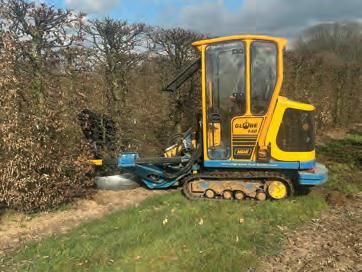
Theobald, Baum & Bonheur’s marketing and communications manager.
“Dieter Lappen was really a plantsman, and you’ll see this in the nursery.
There were quite a lot of things that were precious, like the quality and the emotional connection to trees – you don't want to leave that behind with a new name
Sabine Theobald, marketing and communications manager, Baum & Bonheur
He was always looking for new assortments and shapes, and always growing everything widely space, making sure trees are transplanted every four years up to nine times. That’s still our philosophy today – to maintain that top quality,” adds Mantje. Rather than focusing simply on customer demand, Boom & Bonheur is now also looking to drive it by further promoting the products that it has, and it’s encouraging landscape architects to visit to “show them what the possibilities are.”

Boom & Bonheur grows around 2,500 species of woody plants but sells more than 20,000 species. The likes of Aralia elata iso spinosa (devil’s walking stick), Rhus typhina (stag's horn sumach), Quercus nigra (water oak) and Styphnolobium japonicum (Japanese pagoda tree) line its fields, as well as rows and rows of Metasequoia glyptostroboides (dawn redwood).
Lime trees are its biggest product, and it’s one of the only nurseries to grow them this way. Using the technique of layering, the branches are carefully curved, with the middle twisted and the ends placed into the ground – all by hand – allowing young plants to develop on their own rootstock. The nursery also has a knack for building its own machinery. “The nursery market is small, so you can’t always buy what you need, so we adapt products from
other markets, which is something Dieter Lappen used to do,” says Theobald.
“We are investing in upgrading our machinery and digitalising the company as well,” says Mantje. It has a modern machinery park at its headquarters in Germany, for instance, and has already become a paperless company. It’s now exploring the potential benefits of artificial intelligence (AI), carrying out trials in its field operations for the handling of crop protection products.
species is developing better in southern Germany, the coast in the Netherlands, or in Spain. From this, a list of more climate resilient trees is being created.
We are investing in upgrading our machinery and digitalising the company as well
Martien Mantje, managing director, Boom & Bonheur (the Netherlands)
Over the last couple of years, Boom and Bonheur also installed 192km of drip systems for irrigation. “This makes sure that when we have a dry period, we can still maintain growth; because if you water plants the old-fashioned way – over the leaves in the early morning – then the growth can be set back when temperatures go above 30°. So, we have to change and to keep evolving.”
Under new ownership, the nursery has become more data led, which is helping it to consider the products it needs to sell in the future as well as what it thinks will inspire its clients. As part of this, it’s taking into account how climate change might impact its stock.
It’s looking to research being carried out across Europe at the moment that is studying how trees are impacted in different areas of the continent. For instance, whether one
Boom & Bonheur is also taking part in research that considers how the climate in 2085, such as prolonged periods of drought, might impact growth.
“They’re creating those conditions in a glasshouse and trialling the resilience of plants in there, making phenotypes and looking at whether that assortment of plants will grow well in that situation in 2085. If we have the results of that in five years, then we can start growing more of that assortment.”
Alongside studies focused on climate change, the nursery is involved in a four-year European project with a Dutch partner,


looking at how to reduce chemicals and use biological treatment instead for mildew fungus. Sensors collecting data on the trees will help to forecast when and how to treat trees more efficiently and effectively.
In other words, Boom & Bonheur is investing heavily, both in the short- and long-term outlook for the nursery. We meet at the existing headquarters, which Theobald says has become somewhat of a “maze” after numerous renovations, with spread out offices and apartments for salespeople or seasonal workers.
Next year, it will be moving its headquarters to a listed building, though. The former manor house, Haus Caen, is surrounded by an English landscape style park with historical trees – a fitting site for the nursery, with its name and roots. Only the logistics team and the nursery site’s management will be based on the current site.



It has also set its sights on growing its foothold in the UK market. At FutureScape last year, Mantje bumped into Landform Consultants’ managing director Mark Gregory and spoke to him about the possibility of doing a garden at the RHS Chelsea Flower Show. That’s when Gregory explained the concept behind The Glasshouse Collective, a carefully curated showroom of high-end


outdoor living products that opens at the end of April. Boom & Bonheur are now supplying this as well as two show gardens being built by Landform Consultants at this year’s Chelsea, one for Catherine MacDonald and another for Baz Grainger, and they’re potentially supplying two more.
The change to Britain’s import rules last year, with introduction of Border Control Posts, makes the timeline slightly more difficult to predict, but Boom & Bonheur is used to exporting to a range of countries, from Switzerland to Uzbekistan to as far as Singapore. “There’s still a lot of room for us to expand in the UK,” says Mantje.
There’s still a lot of room for us to expand in the UK
Martien Mantje, managing director, Boom & Bonheur (the Netherlands)
There are new markets it’s dipping its toe into as well, such as Saudi Arabia. Boom & Bonheur will be exhibiting at the inaugural FutureScape Global in Riyadh on 28 and 29 April. “It started out as curiosity about what is
happening in that part of the world and the possibility of sending trees there. Saudi Arabia is a developing market that we should at least be trying to get into. There are huge projects going on there to drive worldwide tourism over the next few years. Just having our name on the exhibitor list has led to people emailing us, but it’s better to meet people face to face to understand their company and what they’re looking for.” It has the same approach wherever it sells its trees, encouraging people to visit the nursery as well and to see the quality of the products themselves. And the steps it’s taking to build more connections, ensure the longevity of its stock and make the nursery ultimately more profitable all put Boom & Bonheur in a position to make 130 years just the start of a long history.


We’ll help you select your plants.
We’ll source and deliver your order.
We offer planting and installation options. We’ll support you with our warranty and our follow-up care.

“Tendercare
We

- Will Allerton, Director, Allerton Landscape Design





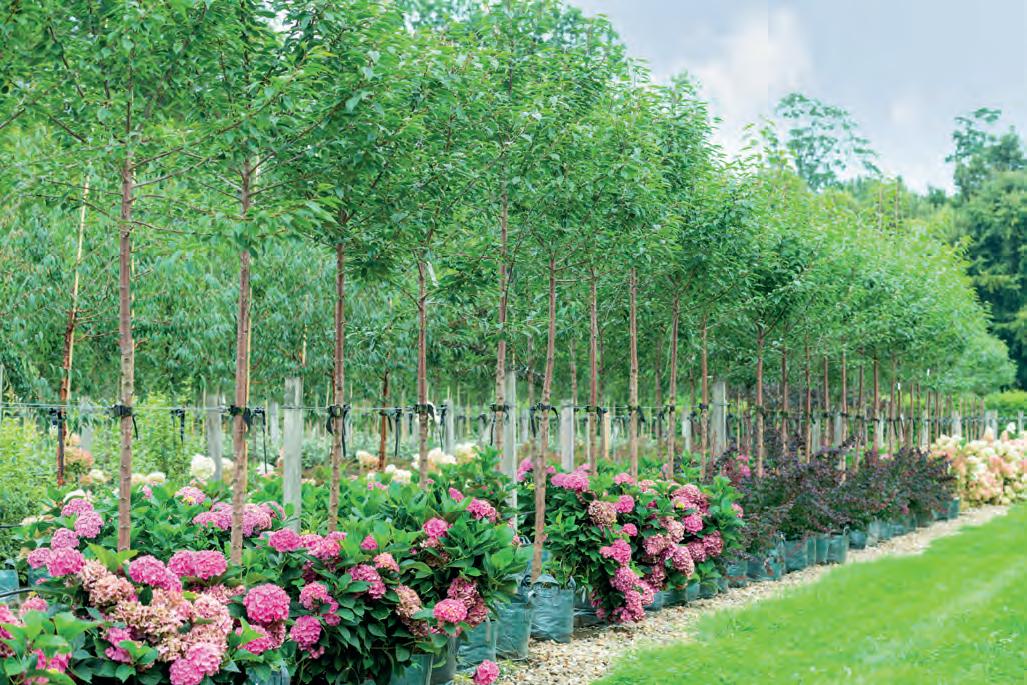



bad,
WORDS: BETHANY VANN
To make good on its commitment of delivering 1.5 million new homes during this parliament, the government has announced its planning reform agenda which aims to speed up the development of homes and key infrastructure, to ultimately unlock additional economic growth – or so the government says. Like with any new legislation of this magnitude, its potential for knock-on effects, good or bad, is plentiful – prompting the question, what impact will the reform have on our industry?
With an increase of 30-35% on the current rate of delivery, it’s a “big deal” says Helmrig’s managing director Dave Gallagher. “These new homes will all need gardens and amenity spaces that need planning, building and maintaining”; on a base level, this will create more work for the industry and ultimately generate more revenue. Gallagher notes the measures to streamline planning decisions through the reform is “welcome, and if successful, will generate new commercial opportunities for our industry, and every other trade involved in the construction”. President of the Landscape Institute (LI), Carolin
Göhler is in agreement, noting the proposed bill is welcome, and that the LI recognises “its potential to streamline regulation, and to encourage sustainable development and economic growth”.
Time and time again, the importance of collaboration has been rightfully accredited to meeting our industry targets, but Gallagher says as a whole the industry is “fragmented” –the “traditional ‘competitive tender’ procurement model that still prevails across much of the construction industry can present a barrier to effective collaboration”. He is hopeful that if the planning reforms can be “effective in speeding things up” it could give developers more confidence to ask for “late changes to the plan knowing that the local authority will reach a decision faster – that can only help.” Going on to say he also hopes that process “encourages” developers to partner with organisations who work together on a “consistent basis, project-after-project, as a close-knit team – facilitating better collaboration and faster decision making”.
Speaking from experience, Gallagher recalls several occasions where it would
A Nature Restoration Fund will be established to ensure there is a win-win for both the economy and nature by ensuring builders can meet their environmental obligations faster and at a greater scale by pooling contributions to fund larger environmental interventions. These changes will remove time intensive and costly processes, with payments into the fund allowing building to proceed while wider action is taken to secure the environmental improvements we need. gov.uk
have been “helpful” to have a phone call or meeting with the local council of one of Helmrig’s current projects to discuss aspects of the planning application, which Gallagher says adds delay and cost to the project –“so it is good that we are streamlining the process.”
It is the government’s hope that the new Bill will also facilitate faster delivery of national significant infrastructure projects (NSIP) – this refers to the creation of roads, railways and additional urban utilities. This rise in project quantity, both commercially and domestically, should in theory result in more green spaces suited to wildlife through the biodiversity net gain legislation (BNG), which is scheduled to come into effect for NSIPs later this year. When working towards BNG, developers are tasked with delivering a mandatory percentage uplift, this can be through on-site and off-site solutions or through the purchase of BNG units. However, outlined in the new Bill is the Nature Restoration Fund, which will be established to ensure there is a ‘win-win’ for both the economy and nature; “so much progress has been made in recent years (thanks to BNG and other changes) in putting the need for well-designed landscapes, habitats and amenity spaces on the developers’ agenda”, says Gallagher – “we need to be careful not to create a situation where that goes away and developers just pay into a central pot and then don’t worry about what happens local to their site”. Funding off-site nature recovery rather than promoting on-site initiatives could result in fragmented and isolated green spaces, rather than fostering integrated green solutions across urban environments. Göhler comments: “We [the LI] are concerned that changes to the Nature Restoration Fund could allow developers to opt out of on-site mitigation obligations. This could lead to biodiversity loss and a reduction in people’s access to nature – vital for our health and wellbeing”, she adds that “on-site mitigation is crucial for genuine, long-term benefits for people, place and nature.” The LI is urging government to “engage closely with landscape professionals to ensure sustainable, resilient natural environments that support the wellbeing of communities”.
The reform is “welcome, and if successful, will generate new commercial opportunities for our industry, and every other trade involved in the construction
Dave Gallagher, managing director, Helmrig
"The Planning System Reform will significantly impact planning applications, including how the UK assesses and mitigates environmental impacts. By shifting from case-by-case measures to strategic, area-wide interventions, the reforms aim to accelerate development. However, this approach introduces uncertainty for crucial initiatives like Biodiversity Net Gain (BNG), which rely on localised, site-specific assessments to be most effective."
"BNG is a game-changer for nature recovery, using site-specific assessments to not only measure the impact of developments on biodiversity but also to actively enhance it. By following the mitigation hierarchy, it ensures environmental gains are delivered close to the site, creating stronger ecosystems where they matter most."
"BNG has already seen remarkable success, ensuring developments deliver at least a 10% biodiversity uplift while aligning with house building targets. The industry has adapted well, and the policy is already driving measurable improvements in environmental outcomes. The government’s development and nature policy paper in December explicitly stated that BNG would not be affected by the reforms, yet no further detail has been provided on how these schemes will integrate. Without clarity, this uncertainty risks slowing progress at a time when momentum is building."
"With BNG already proving its value, the focus should be on strengthening its implementation, not creating unnecessary disruption. Stability and clarity will be key to ensuring continued success for both nature and development."
Oliver Lewis, CEO of Joe’s Blooms

While Gallagher is hopeful the new Bill will bring about necessary change, he is cautious of the push back from another legislation of this magnitude: “We can’t afford to be an industry that says “no”. We’re not here to become an extension of the environmental regulators. Yes, we have to do things with integrity and we’re the ones who will deliver the environmental benefits, but we have to remember the customer and the need to solve their problems to get developments moving.” In January, the Committee of Public Accounts published a report highlighting the current state of homelessness in the country, stating that levels are at their highest since records
We [the LI] are concerned that changes to the Nature Restoration Fund could allow developers to opt out of on-site mitigation obligations. This could lead to biodiversity loss and a reduction in people’s access to nature – vital for our health and wellbeing
Carolin Göhler, President of the Landscape Institute (LI)
began, with 123k households in England being housed in temporary accommodation as of June 2024.1
In 2023-24, the cost of providing temporary accommodation rose to over £1.6bn, a pressure that lies on the shoulders of local authorities. The report underscores the need for more affordable housing, which the reform looks to rectify. The key to capitalising on the new system, Gallagher says is “finding
the right balance between benefit for the environment, delivering the landscape for future generations, and solving problems to get developments moving”. He notes that the current system requires developers to commission an excess of reports from multiple specialists to support their plans, which incurs additional fees – “for the local authority, they somehow have to generate the capacity to read and understand the whole dossier of evidence.
If planning gets more expensive, and affordability of the end product is already stretched, that’s less money in the pot for “discretionary” stuff like more investment win landscaping to improve visual appeal
Dave Gallagher, managing director, Helmrig
The whole process of writing reports, reading reports, considering recommendations and then making a decision, takes a long time, and costs a fortune!”
The new planning bill will also allow councils to set their own planning fees to recover application costs, and while Gallagher says he would like to think that “efficiencies and savings will come from streamlining the process, realistically this can only mean one thing – it’s going to be more expensive
for developers to gain planning – that's not good news.” Property specialist Zoopla reported that the average house price in the UK as of February 2025 is £267,200, with property prices now at +1.9% inflation compared to a year ago, with prices set to rise by 2.5% by the end of the year. “If planning gets more expensive, and affordability of the end product is already stretched, that’s less money in the pot for “discretionary” stuff like more investment in landscaping to improve visual appeal”, notes Gallagher.
"THE NEED TO PROTECT OUR NATURAL CAPITAL"
While the need for affordable housing is one of significant importance, so is the need to protect our natural capital – creating sustainable homes with landscape consideration employed from the off-set is vital. The new green design tool, elemental – spearheaded by Liz Nicholson, managing director of Nicholsons – is designed to support garden designers, landscape architects, and landscapers bolster their natural capital when designing and creating outdoor spaces. Nicholson says the team behind elemental will actively be looking to support the housing targets and to facilitate their sustainable development.
“It’s essential that the regulatory framework fosters sustainable development and ensures that nature, landscape and the wider environment is enhanced through the development process – delivering benefits to people, place and nature.” adds Göhler.
Only time will tell how the new planning reform will work alongside already established legislation, such as BNG. Much like BNG, this new reform will undoubtedly cause ripples as the industry and its partnering sectors adjust, but will hopefully result in a system that holds both development and the natural environment at the same level of importance – Gallagher affirms that “whatever happens to the planning system, it’s up to us to find the right balance between benefit for the environment, delivering the landscape for future generations, and solving problems to gain planning permission and stay within the regulations.”
1. Committee of Public Accounts (January 2025) Tackling homelessness. committees. parliament.uk/publications/46302/ documents/233214/default
















We’re increasingly able to measure our impact on the world – at least through our carbon output. Businesses are rightfully looking at their output and investing time and resource into the decarbonisation of their work. These processes can involve huge change, but cumulative small changes all make a difference.
A 2022 Oxford University advisory paper calculated a saving of 69kg of CO2 per year saved for each PC turned off rather than asleep each night. That might not be huge when we consider the 37.41 billion tons of CO2 put into the atmosphere in 2024 alone (statista.com), but if we all endeavour to make improvements in decarbonising our lives, then the big number gets smaller.
Yes, developing industrial countries are pumping out vast amounts of carbon into the atmosphere; but so are the supposed developed ones and much of that comes from our never-ending need for energy. Whether it’s energy to power cloud storage servers to save digital photos, AI’s consumptive energy needs, or for our increased use of electronics, we demand a lot more energy from our providers than ever before. The net reality of these demands is increased carbon production. It can be lowered with greater use of renewable, but we need to look at multiple ways to both reduce and offset our carbon impact.
We collectively need to look to make energy savings including little things like turning off lights when not using them and considering
the journeys we take with a single person in a car. Businesses should look at how much they spend when leaving lights or computers on when not being used. They should look at vehicle use and whether they can utilise renewable energy on their premises. In some cases, there are big savings to be made as well as lowered carbon output.
The carbon credit market is a big growth sector and while biodiversity net gain seeks to ensure a 10% biodiversity increase to developed sites from their original levels, carbon credit purchases enable organisations to make a positive carbon impact internationally. Projects like tree planting, coastal mangrove foresting, fuel change initiative, modernising tech for agriculture, renewable infrastructure and more all improve the world, but often not at the source of the output. Personally, I struggle with the idea of offsetting carbon thousands of miles away from where you are producing it, and while I naturally support tree planting projects in Africa and South America, they don’t easily connect to a business in the UK where its carbon output is impacting. It isn’t that I don’t believe the work is being carried out, but I think we need to get more creative with how carbon credits are being spent, so that international contributions are
Let’s get creative with carbon offsetting, says Lewis Normand
part of the picture, but local benefits are realised as well.
If we all endeavour to make improvements in decarbonising our lives, then the big number gets smaller
I would like to see macro algae rewilding projects like kelp forests in the UK that have been dredged to get access to fish stocks, and local authorities given funding to develop underfunded public parks and to turn unused land into ecologically diverse, environmentally and culturally beneficial planted spaces. I’d like to see increased green walls, urban cooling planting, pocket parks, nature corridors, expansions to our national forests, school gardens, community food-for-free spaces and more all funded with carbon crediting to enable businesses to impact on the local climate as well as further afield.
If the value of carbon credit sales becomes more than an offsetting exercise and evolves into a locally beneficial system that contributes to the communities that it exists within as well as the environment, then we all win. I think we can do big things in the next 10 years. As well as helping our carbon credentials, we can support areas that are increasingly underfunded against tightening budgets.

Lewis Normand has worked in a wide variety of roles within horticulture over a 20-year career. He has lectured on garden design and horticulture, and designed gardens in the UK, Europe and the Middle East. Since 2011, Lewis has focused on nursery sales, now working as sales manager at Bernhard’s Nurseries, and has helped to launch a number of new plants into the UK plant market. He is a specialist supplier to show gardens, supplying more than 100 gardens at major shows.
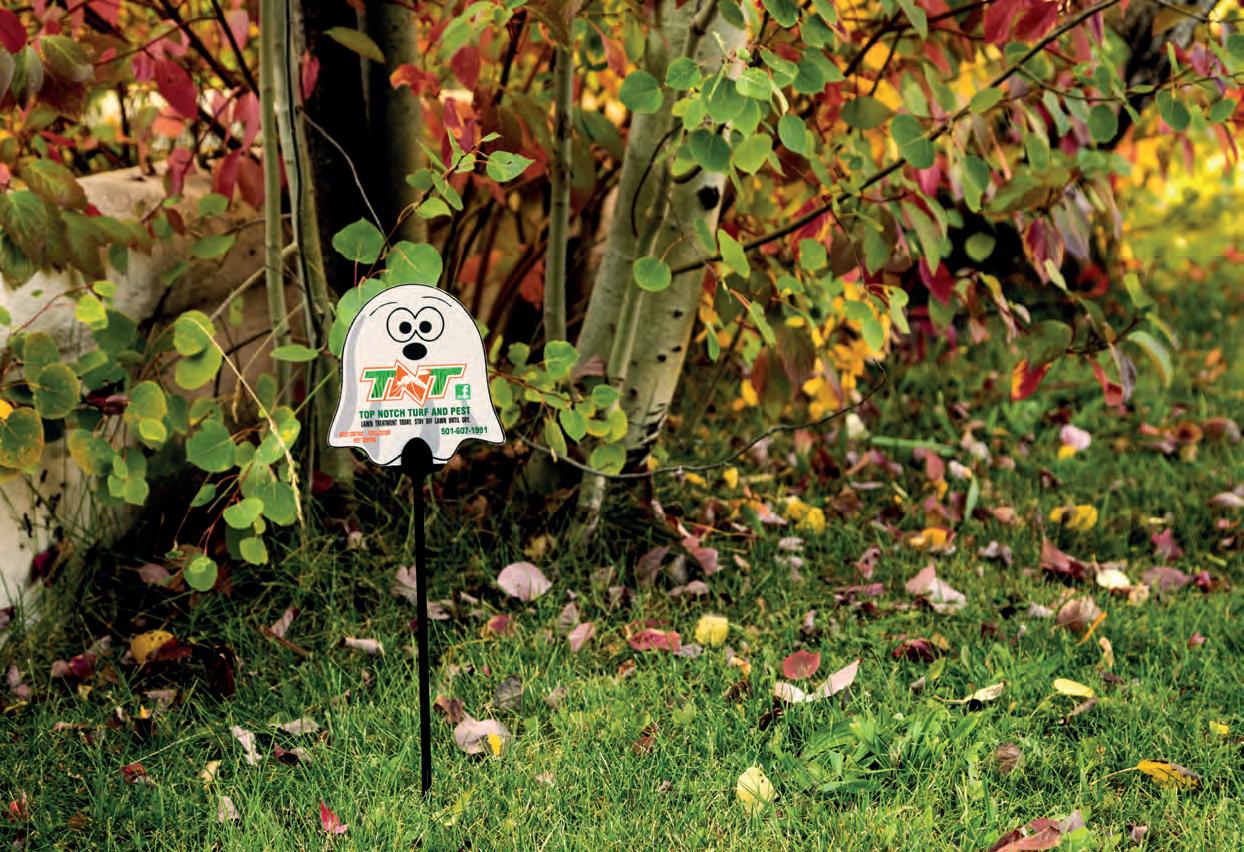



For all your planting projects and beyond why not give Spring Reach Nursery a try. Based in Surrey with over 25 years growing experience supplying leading garden designers and domestic landscapers you can expect a top quality service from initial enquiry through to delivery to site or collection. We have a superb choice of hardy nursery stock including some varieties that are not freely available.
•Always holding good stocks of those ever popular lines for immediate impact from large evergreen screening trees pleached panelled trees and multi-stems and specimen shrubs for immediate impact
•Thousands of Herbaceous perennials, Roses and Grasses for giving your design the wow in Summer and Autumn
•Conveniently situated just 10 Minutes from Junction 10 of the M25
•Deliveries made using own transport up to 150 miles or further a field by the pallet network.
Contact 01483 284769 | email info@springreachnursery.co.uk
Long Reach Ockham Surrey Gu23 6PG www.springreachnursery.co.uk










Humaira Ikram continues her series, shining a spotlight on fuchsias
What’s the link between Jackie O, a German botanist, and your grandma’s garden? Fuchsias!
Jackie O had them on her bedroom wallpaper (thank you, Ffffrenchie); they were named after Leonard Fuchs, and, well, most gardens in England have had a fuchsia in them at some point. But do you think they are stuck in the past? Let me try to convince you otherwise!
Fuchsias are a fascinating link between history, botany, and modern gardening. One of the first Europeans to discover them in the late 1600s was French monk and plant collector Charles Plumier in the Dominican Republic. These plants were named in honour of Fuchs. While they were known locally as "Molle Ecantu," or "beauty bush," fuchsias have since become a staple in gardens worldwide.
Just a quick aside on naming and nomenclature – Carl Linnaeus created the standardised binomial naming system in the 1750s. He classified plants based on their reproductive parts, using Latin names for genus and species. This system, though initially controversial, provided a universal scientific language for botanists and makes it easier to discuss plants on an international basis without confusion; however, it does have its faults.
Fuchsias have sometimes been dismissed as old-fashioned. However, their versatility and charm make them worthy of reconsideration

Decolonising plant names has become an issue of late.
Decolonisation of names such as Uluru instead of Ayers Rock is thought to promote inclusivity, acknowledge indigenous knowledge and rectify some historical injustices, and the same can be done with plant names. Decolonisation of plant names may seem silly or unnecessary to some, but to a lot of overlooked and indigenous peoples – or even just regular and unaffected people – this means a lot. Which other 300-year-old scientific research or ideas have not been challenged or changed? I’d say it’s just due an upgrade.
Back to fuchsias. Once a popular choice in English gardens, fuchsias have sometimes been dismissed as old-fashioned. However, their versatility and charm make them worthy of reconsideration. These robust shrubs thrive in sunny or lightly shaded areas and can adapt to a variety of soil types, from damp to well-drained.

One useful and I think noteworthy variety is Fuchsia 'Hawkshead' – a hardy deciduous plant that withstands temperatures down to -10°C. This cultivar features delicate white flowers with a hint of green, reaching about one metre in height. Its dark green foliage provides an excellent backdrop for other plants and works well in groups or as a low hedge. Fuchsias are beneficial for late summer pollinators too, originally adapted to be pollinated by hummingbirds but now attracting local fauna as well. When planning a garden, consider pairing fuchsias with other plants that enjoy partial shade – for example:
• Heucheras: The green-foliaged 'Greenfinch' offers a striking contrast with its upright flowers.
• Anemones: 'Honorine Jobert' provides elegant blooms that complement fuchsias beautifully.
• Grasses: Options like Sesleria autumnalis or various Carex species can create a serene transition between plants.
As we face the complexities of climate change, revisiting resilient plants like fuchsias could be beneficial. Their origins in diverse climates suggest they may adapt well to changing conditions in our gardens. I would say that fuchsias deserve another go and maybe a place in our contemporary planting schemes. Their enduring beauty and adaptability make them not only a nostalgic choice but also a practical one for today’s gardeners.

HUMAIRA IKRAM
Humaira Ikram has been working as a professional garden designer at Studio Ikram for over 10 years. She runs the Garden Design Diploma at the KLC School of Design, is a gardens advisor to RHS Hyde Hall, and a judge and on various selection and advisory panels for the RHS. She is co-curator of the newly established thehub.earth, and is an award-winning broadcaster who has contributed to BBC Radio 4 Gardeners Question Time, been part of garden focused TV and media campaigns and programmes and writes for various gardening magazines. studioikram.com thehub.earth
Goodwood Downs Course
12 June 2025

Experience the perfect blend of golf and networking, at the prestigious Goodwood Downs Course, one of the finest golfing venues in the country. Whether you’re a seasoned golfer or a passionate enthusiast, this event offers an unforgettable day on a championship course.
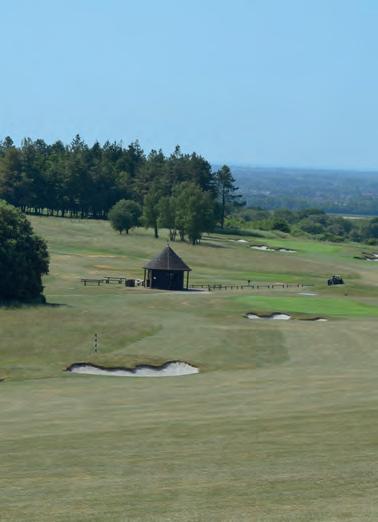
What’s Included
• Entry for a Fourball to this exclusive tournament.
• Breakfast to kickstart your day.
• A spectacular 18 holes of golf on the world-renowned Goodwood Downs Course.
• BBQ lunch served post-game, perfect for unwinding and networking.
• Refreshments and camaraderie throughout the day.
Entry Fee
£1,000 for a Fourball team



Don’t miss your chance to enjoy an incredible day of golf at Goodwood Downs Course, Chichester



For all your
sportsturf and landscape irrigation needs. Buy online at www.lws.uk.com


CIS Street Furniture offer a diverse range of street furniture which will complement any location.
As a result of the built environment compaction can inhibit or prevent natural root growth of trees. CIS SUDs compliant resin bound tree grilles are a great way of enhancing the sustainability of your project for future generations. Find out more at our website below.
Tel: 01483 203388 www.cis-streetfurniture.co.uk
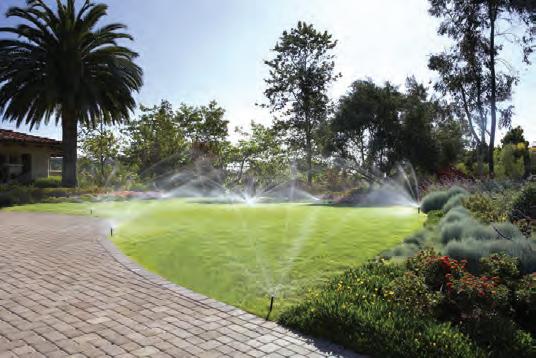
























As the Society of Garden Designers transforms into the Society of Garden + Landscape Designers, chair Andrew Duff MSGLD explores the evolving relationship between garden and landscape design
Where do we begin? The question, ‘What is a garden?’ is often embedded in garden design education. It may seem like an easily answered question – perhaps even as simple as saying, ‘It is subjective.’ What one person considers a garden does not have to align with another’s perception and therein lies the beauty of our profession. The diversity of perspectives, aesthetics, and philosophies is what makes garden design such a rich and evolving discipline.
For many designers, their approach to a garden reflects their core beliefs about what a garden should be. Some create controlled, linear, structured environments, while others embrace a looser, wilder aesthetic. Clients, too, have choices – an array of styles, methodologies, and inspirations to suit their personal needs and desires. Despite global influences constantly reshaping design ideologies, the English garden remains one of the most revered and influential garden styles worldwide. Perhaps, in the digital age, where limitless inspiration is just a click away, we take this honour for granted. The ever-changing face of garden design constantly challenges our preconceptions, urging us to rethink our understanding of what a garden truly is.
If a garden is defined by use and pleasure, then can an entire landscape, designed with aesthetic intent, also be considered a garden?

may have begun. Imagine early humans seeking shelter in caves, retreating from the harsh elements and the dangers of an exposed landscape. Picture yourself there, gathered around a fire, nurturing your family, eating food hunted and foraged from the surrounding wilderness.
So, let us return to the fundamental question: What is a garden? To explore its origins, we must first consider how gardens
The winters are bitterly cold. The wind howls through the cave entrance. Seeking protection, you gather branches and construct a simple barrier to shield against the elements.
Over time, this rudimentary enclosure evolves – you interweave the branches for strength, anchor them with stones and soon the space extends beyond the cave itself, forming a defined outdoor area. As your needs grow, so does the enclosed space. You begin keeping animals, perhaps even cultivating early crops. Boundaries emerge, not merely for survival but as an assertion of control over the land. A garden is born.
This progression is not as improbable as it may seem. The people of 40,000 years ago were sophisticated, creating intricate fertility carvings, elaborate cave paintings, and functional tools. Establishing enclosed spaces for protection and sustenance would have been a natural extension of their ingenuity.
But does a garden require boundaries? Perhaps it depends on scale. History provides further insight. The deforestation of the Amazon has revealed ancient clearings, long buried beneath the dense canopy. Archaeologists, using drone footage, have identified circular enclosures dating back to 3000 BCE. These settlements, surrounded by ditches and thorny hedges, likely served to contain livestock or protect early crops. The circular formations suggest that, unlike modern gardens with rigid property lines, these early enclosures reflected an organic relationship with the land. Can we consider these early settlements gardens in their own right?
The renowned landscape designer Humphry Repton, a champion of the picturesque movement, defined a garden as ‘a piece of ground fenced off from cattle and appropriated to the use and pleasure of man; it
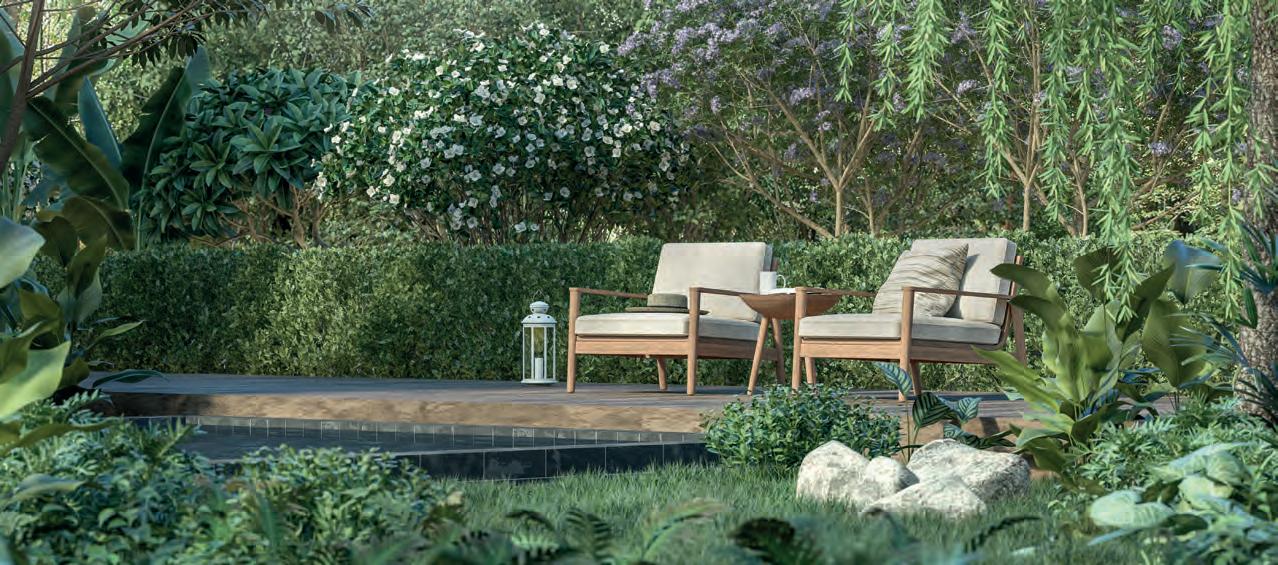
is or ought to be cultivated.’ The word ‘appropriated’ is particularly interesting, as it implies ownership, a controlled environment created for human use. Repton’s work was rooted in grand estates where landowners had the luxury of vast landscapes extending to the horizon. His picturesque landscapes were designed to resemble oil paintings, framed by gilded borders, seamlessly blending controlled beauty with the untamed natural world. Repton’s definition begins to blur the lines between garden and landscape. If a garden is defined by use and pleasure, then can an entire landscape, designed with aesthetic
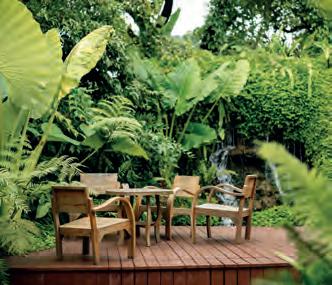
intent, also be considered a garden? Today, most people view a garden as a purposeful and aesthetically driven space, distinct yet often integrated with its surroundings. Some gardens expand to monumental scales, where the ‘borrowed landscape’ beyond the immediate boundaries becomes part of the visual composition. A vast meadow,
a woodland, even an entire forest – are these not gardens, simply on a grander scale?
In contemporary design professions, we have neatly compartmentalised roles: garden designers traditionally focus on residential spaces, while landscape architects tackle public projects. Yet, do such strict definitions serve us well? History is filled with figures who defied categorisation.
Michelangelo was not confined to painting alone; he designed buildings. Roberto Burle Marx, known for his landscapes, also created textiles and dynamic floral arrangements. Why, then, should we constrain ourselves within rigid professional boundaries?
gardens have been places of utility, reflection, and artistic expression, evolving with culture, climate, and personal philosophy.
“Ultimately, a garden is what you make of it – an outdoor space given meaning, care, and purpose. How do you define a garden?”
An outdoor space is just that – a space awaiting transformation. It is the role of garden and landscape designers to imbue these spaces with meaning
I asked a well-known AI powered assistant, what is a garden? Its response is reassuring: “A garden is a cultivated outdoor space designed for beauty, function, or both. It can be as small as a windowsill planter or as vast as a sprawling landscape. At its core, a garden is a place where nature is intentionally shaped – whether for aesthetics, food production, biodiversity, or personal retreat.
“Gardens can be formal or wild, structured or free flowing. They might serve as sanctuaries for people, habitats for wildlife, or productive lands for sustenance. Historically,
An outdoor space is just that – a space awaiting transformation. It is the role of garden and landscape designers to imbue these spaces with meaning, to craft places that serve both people and nature. Whether large or small, urban or rural, for human enjoyment or ecological benefit, the essence of a garden lies in its ability to evoke connection, beauty, and purpose. The Society of Garden and Landscape Designers embraces this philosophy, welcoming those who seek to shape the world beyond walls into spaces of inspiration and life.

ANDREW DUFF
An internationally recognised garden designer, Andrew Duff
has been designing gardens for over 30 years. In addition to running his practice, he is managing director of the world renowned Inchbald School of Design and is Chair of the Society of Garden and Landscape Designers. sgld.org.uk






7 - 8 October 2025 ExCeL London
TWO UNMISSABLE DAYS
WORLD CLASS
SECTOR-SPECIFIC EXHIBITORS
LEADING CPD-ACCREDITED SEMINAR PROGRAMME WITH EXPERT SPEAKERS
HANDS-ON FEATURES AND DEMOS
NETWORKING OPPORTUNITIES





